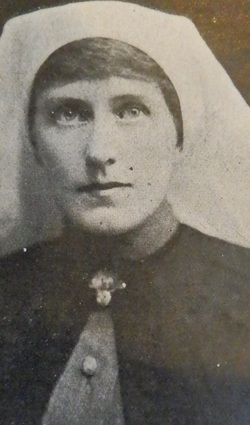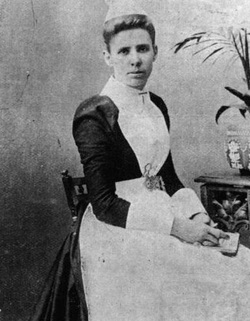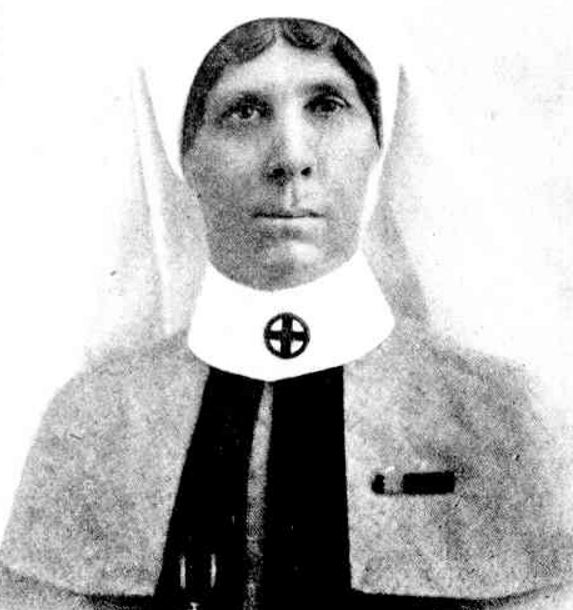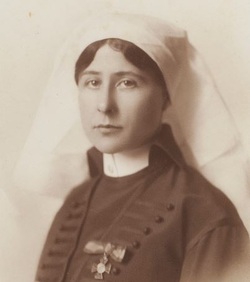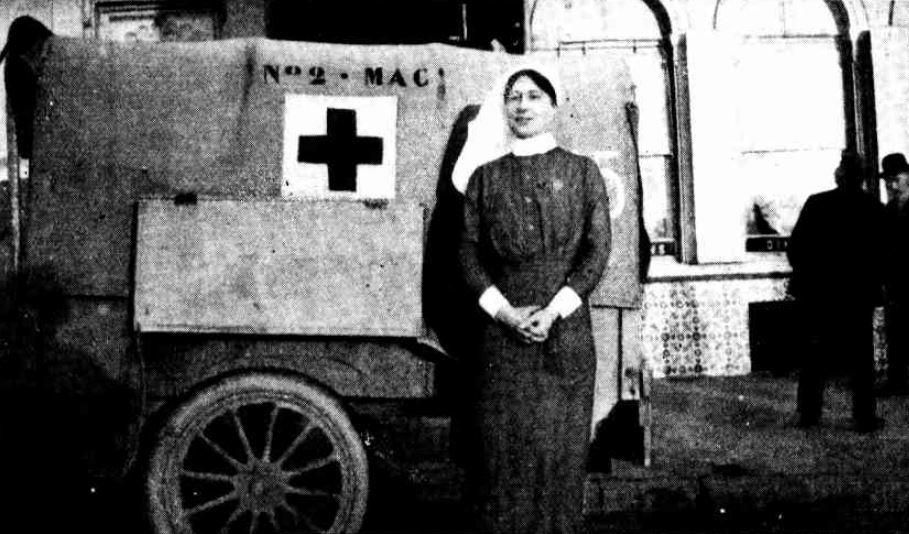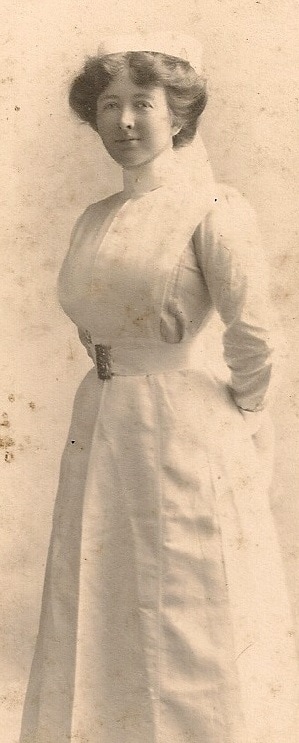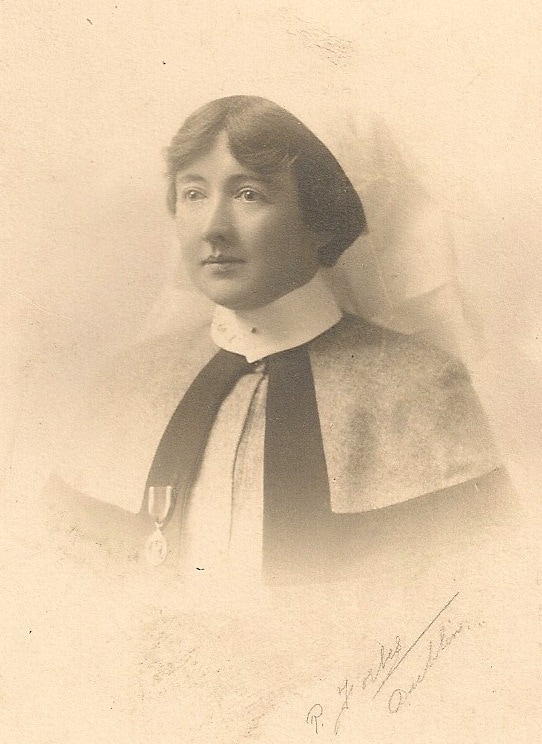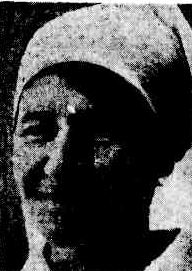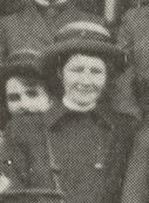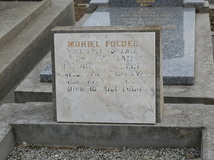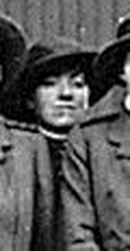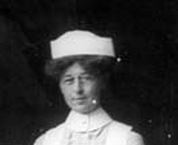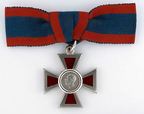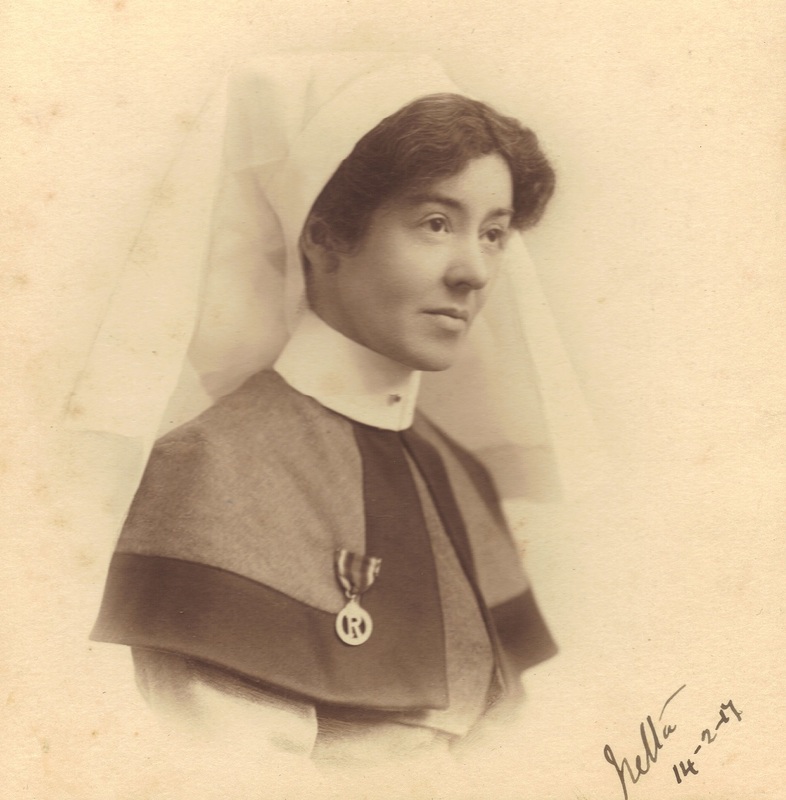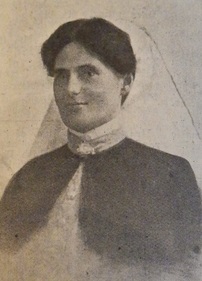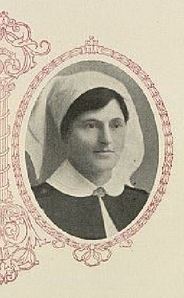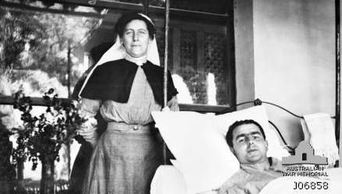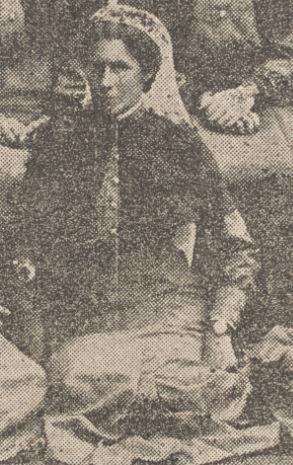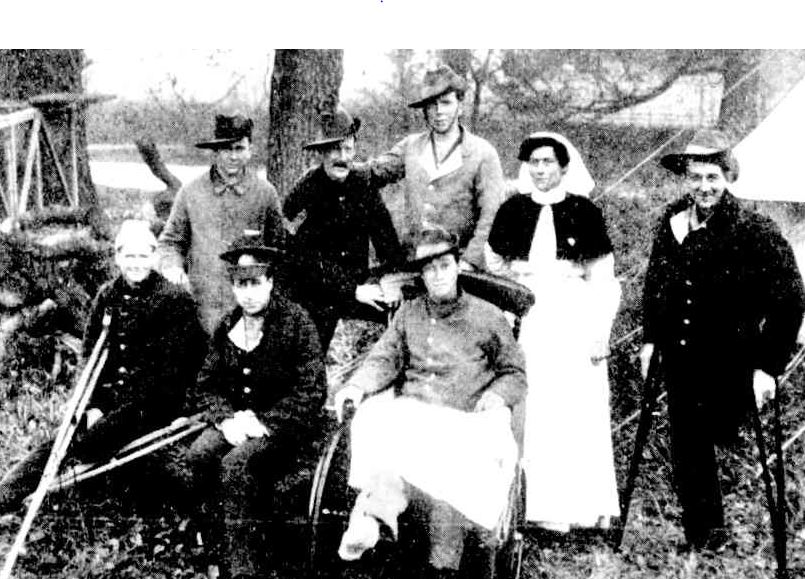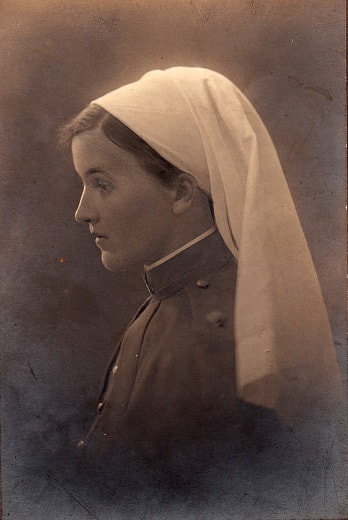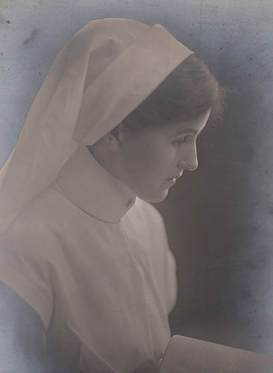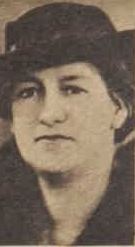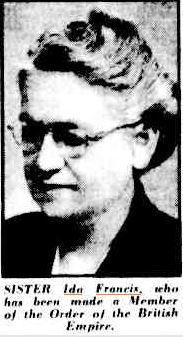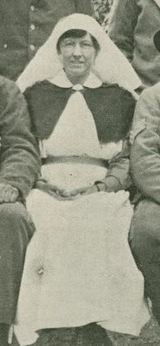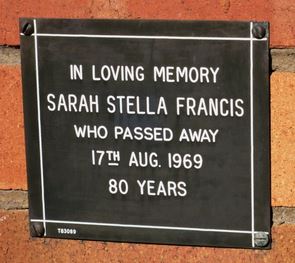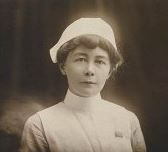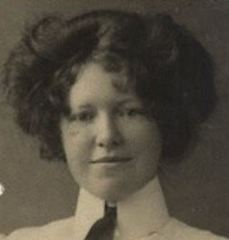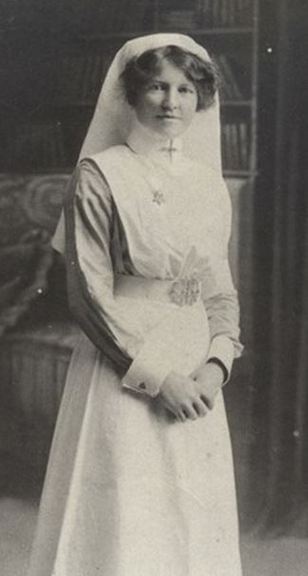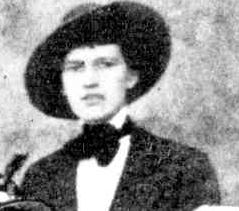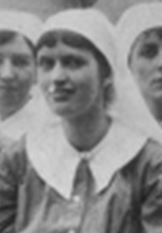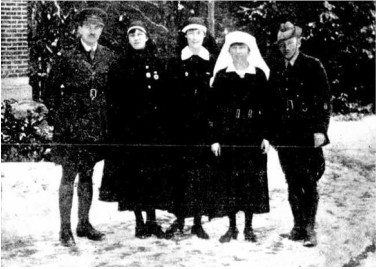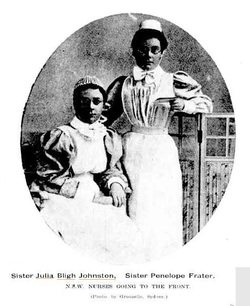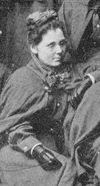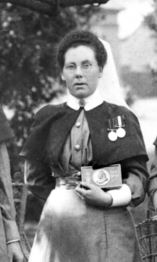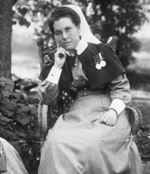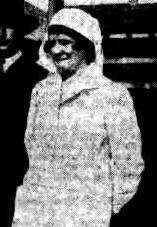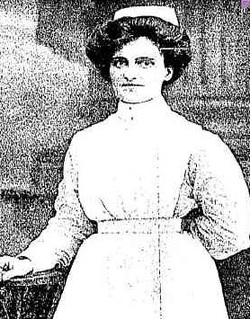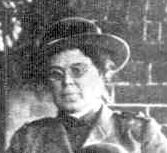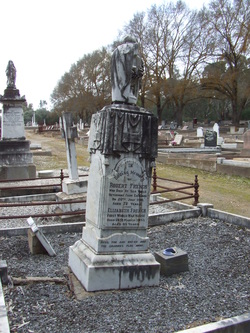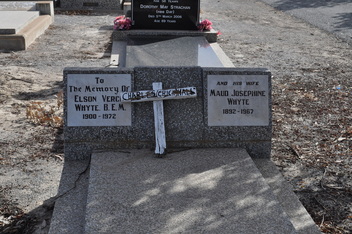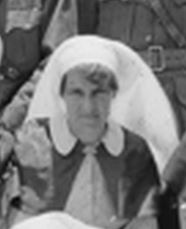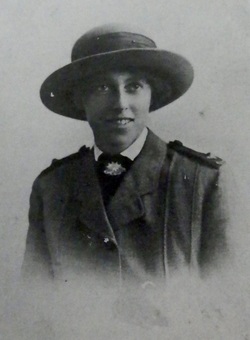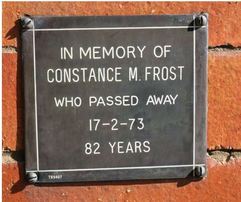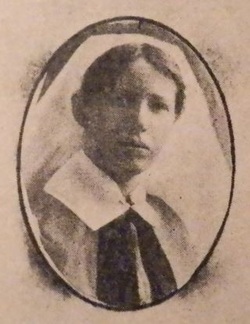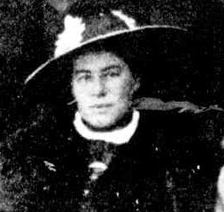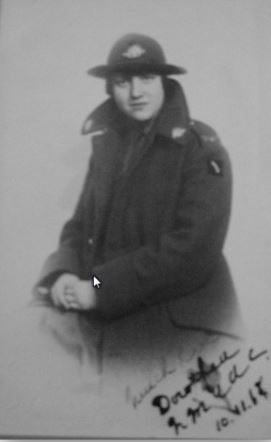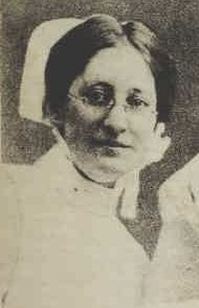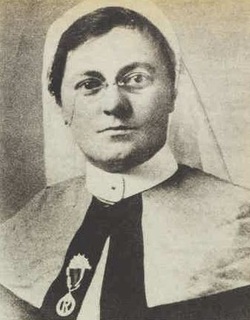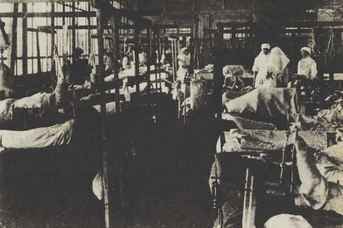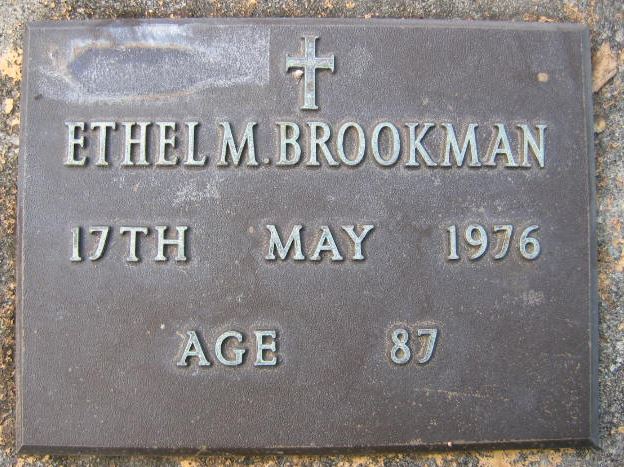FLAE, Vera Jean
Staff Nurse
AANS
Born 1893 in Heathcote, Vic.
Daughter of James William FLAE and Emily Elizabeth nee BATWAY
Of 'Yaralla' 90 Droop Street, Footscray, Vic.
Her surname at birth is given as Flee. There is a letter on her file at Archives stating that her name Flae is incorrect and should be Flaye.
Occupation prior to enlistment Trained Nurse
Enlisted 10 September 1917
Aged 24 years
Embarked 08 November 1917 per 'Canberra'
Served at King Georges War Hospital, Poona
Returned to Australia 08 May 1919 per 'Eastern'
Appointment terminated 26 October 1919
Did not marry
Died 22 February 1954
AANS
Born 1893 in Heathcote, Vic.
Daughter of James William FLAE and Emily Elizabeth nee BATWAY
Of 'Yaralla' 90 Droop Street, Footscray, Vic.
Her surname at birth is given as Flee. There is a letter on her file at Archives stating that her name Flae is incorrect and should be Flaye.
Occupation prior to enlistment Trained Nurse
Enlisted 10 September 1917
Aged 24 years
Embarked 08 November 1917 per 'Canberra'
Served at King Georges War Hospital, Poona
Returned to Australia 08 May 1919 per 'Eastern'
Appointment terminated 26 October 1919
Did not marry
Died 22 February 1954
FLEMING, Doris
Staff Nurse
AANS
Born Louisa Doris FLEMING 1892 in Brisbane, Qld.
Daughter of William Scott FLEMING and Louisa nee STOREY now DOBSON
Of 'Camaraggal' Rangers Avenue, Mosman, NSW
Occupation prior to enlistment Nursing
Enlisted 28 August 1917
Aged 25 years
Embarked 16 November 1917 per 'Canberra' from Sydney
Served in Egypt
Returned to Australia 27 July 1919 per 'Hungaria'
Appointment terminated 07 November 1919
Married 1919 to Robert P FIELD in Sydney NSW
Remarried in Mosman NSW in 1950 to Charles NEWICK
Died in 1968 in St Leonards NSW
AANS
Born Louisa Doris FLEMING 1892 in Brisbane, Qld.
Daughter of William Scott FLEMING and Louisa nee STOREY now DOBSON
Of 'Camaraggal' Rangers Avenue, Mosman, NSW
Occupation prior to enlistment Nursing
Enlisted 28 August 1917
Aged 25 years
Embarked 16 November 1917 per 'Canberra' from Sydney
Served in Egypt
Returned to Australia 27 July 1919 per 'Hungaria'
Appointment terminated 07 November 1919
Married 1919 to Robert P FIELD in Sydney NSW
Remarried in Mosman NSW in 1950 to Charles NEWICK
Died in 1968 in St Leonards NSW
FLEMING, Elizabeth Gertrude
|
Head Sister
AANS No 1 Australian Stationery Hopsital Born 1879 in Brunswick, Vic. Daughter of William FLEMING and Janet nee WEIR Occupation prior to enlistment Nurse Enlisted May 1914 Aged 35 years Embarked 28 November 1914 Served in England and France Returned to Australia 08 February 1919 per 'Miltiades' Appointment terminated 12 April 1919 Married William HUNTER in 1922 Died 26 March 1969 in Essendon, Vic. Resied Essendon, Vic. Photograph Table Talk Thursday 26 November 1914 page 3 |

Awarded Royal Red Cross (2nd Class)
Date of Commonwealth of Australia Gazette: 25 July 1917
Location in Commonwealth of Australia Gazette: Page 1544, position 26
Date of London Gazette: 23 February 1917
Location in London Gazette: Page 1950, position 6
Date of Commonwealth of Australia Gazette: 25 July 1917
Location in Commonwealth of Australia Gazette: Page 1544, position 26
Date of London Gazette: 23 February 1917
Location in London Gazette: Page 1950, position 6
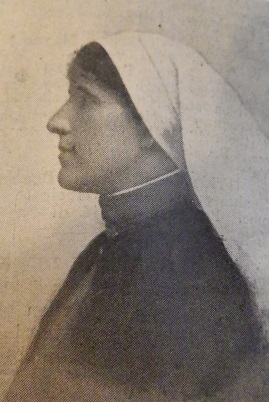
Mentioned in Despatches
In 1918, Sister E. Gertrude Fleming, now In charge of the Military Sanitorium at Macleod, received the Royal Command to attend Buckingham Palace so that she might be invested with the Royal Red Cross (Second Class). When war was declared, Miss Fleming was a member of the Australian Army Nursing Service, and at once volunteered for military duty. She worked in hospitals at Heliopolis and Ismailia, Egypt, and then went to Dartpool Military Hospital, England. After some months with the Fifth British Stationary Hospital in France, she was given charge of the First Australian Casualty Clearing Station, in which position she remained till the Armistice was signed. Sister Fleming was mentioned in Sir Douglas Haig's despatches. She trained at the Melbourne Hospital.
In 1918, Sister E. Gertrude Fleming, now In charge of the Military Sanitorium at Macleod, received the Royal Command to attend Buckingham Palace so that she might be invested with the Royal Red Cross (Second Class). When war was declared, Miss Fleming was a member of the Australian Army Nursing Service, and at once volunteered for military duty. She worked in hospitals at Heliopolis and Ismailia, Egypt, and then went to Dartpool Military Hospital, England. After some months with the Fifth British Stationary Hospital in France, she was given charge of the First Australian Casualty Clearing Station, in which position she remained till the Armistice was signed. Sister Fleming was mentioned in Sir Douglas Haig's despatches. She trained at the Melbourne Hospital.
FLEMING, Johanna
Sister
AANS
No 1 Australian General Hosptial
Born 29 May 1887 at Callington, SA
Daughter of Michael FLEMING and Anastasia nee CRITCHLEY
Occupation prior to enlistment Nurse
Trained at Kalgoorlie Govt. Hospital, WA
Enlisted 01 April 1916
Aged 28 years
Embarked 01 October 1915 per 'Ulysses'
Served in France
Returned to Australia 02 February 1920 per 'Port Napier'
Appointment terminated 03 April 1920
Married MYERS
Died 09 February 1973 in Perth, WA
Aged 85 years
Resided Mt. Lawley, WA
Buried Karrakatta Cemetery Roman Catholic Lawn 7 0220
AANS
No 1 Australian General Hosptial
Born 29 May 1887 at Callington, SA
Daughter of Michael FLEMING and Anastasia nee CRITCHLEY
Occupation prior to enlistment Nurse
Trained at Kalgoorlie Govt. Hospital, WA
Enlisted 01 April 1916
Aged 28 years
Embarked 01 October 1915 per 'Ulysses'
Served in France
Returned to Australia 02 February 1920 per 'Port Napier'
Appointment terminated 03 April 1920
Married MYERS
Died 09 February 1973 in Perth, WA
Aged 85 years
Resided Mt. Lawley, WA
Buried Karrakatta Cemetery Roman Catholic Lawn 7 0220
FLEMING, Louisa Doris
Staff Nurse
AANS
Enlisted 28 August 1917
Embarked 16 November 1917
Appointment terminated 20 August 1919
ENGAGEMENT.
The engagement is announced of Sister L D Fleming A A N S , A I F , on active service in Egypt, daughter of Mrs L. A. Dobson, Rangers-avenue, Mosman, to 1st Lieut Lawrence Benson Hill, 121st Pioneers, E E F, Indian Army.
Sydney Morning Herald Saturday 07 September 1918
AANS
Enlisted 28 August 1917
Embarked 16 November 1917
Appointment terminated 20 August 1919
ENGAGEMENT.
The engagement is announced of Sister L D Fleming A A N S , A I F , on active service in Egypt, daughter of Mrs L. A. Dobson, Rangers-avenue, Mosman, to 1st Lieut Lawrence Benson Hill, 121st Pioneers, E E F, Indian Army.
Sydney Morning Herald Saturday 07 September 1918
FLEMING, Pearl
Staff Nurse
AANS
Born 1894 at Natimuk, Vic.
Daughter of Thomas FLEMING and Jane/Jeannie nee ROBSON
Of Highway, Nedlands, WA
Occupation prior to enlistment Nurse
Enlisted 19 June 1919 at Fremantle, WA
Aged 25 years
Embarked 18 December 1916 per 'Kaiser-I-Hind'
Served in Egypt
Returned to Australia 11 March 1919 per 'Lancashire'
Appointment terminated 19 June 1919 as medically unfit
Married Charles Robert EDMONDS
Died 1971 in Caulfield, Vic.
Cremated 30 March 1971 Springvale Botanical Cemetery and ashes scattered
AANS
Born 1894 at Natimuk, Vic.
Daughter of Thomas FLEMING and Jane/Jeannie nee ROBSON
Of Highway, Nedlands, WA
Occupation prior to enlistment Nurse
Enlisted 19 June 1919 at Fremantle, WA
Aged 25 years
Embarked 18 December 1916 per 'Kaiser-I-Hind'
Served in Egypt
Returned to Australia 11 March 1919 per 'Lancashire'
Appointment terminated 19 June 1919 as medically unfit
Married Charles Robert EDMONDS
Died 1971 in Caulfield, Vic.
Cremated 30 March 1971 Springvale Botanical Cemetery and ashes scattered
FLETCHER, B
Nurse
Voluntary Aid Detachment
Embarked for Australia 04 June 1919 per 'Bremen'
Voluntary Aid Detachment
Embarked for Australia 04 June 1919 per 'Bremen'
FLETCHER, Gertrude
|
Matron
Queen Alexandra's Imperial Military Nursing Service Reserve Born 26 May 1871 in Auckland, New Zealand (as per enlistment papers but may have been born 1866) Daughter of John FLETCHER and Eliza nee BALE Of 'The Warren' Marrickville, NSW Educated in Australia Trained at Royal Prince Alfred Hospital, Sydney from March 1891 to May 1897 Served in the Boer War Also worked in South Africa and Private Hospital work and was Matron at American Women's Hospital, London Served from 22 March 1915 to 23 February 1919 B Section 51st Stationary Hospital Arrived from Italy 26 January 1919 and resided at St. Andrew's House Club, 31a Mortimer Street, London, W.1. Applied for clerical post in War Office 01 March 1919 Appointment terminated 23 March 1919 Remained in England and still alive in 1950 Did not marry |
THE KING'S ILLNESS. — Considerable interest on the part of Maitlander's attaches to the recent illness of His Majesty the King by reason of the fact that one of the nurses who had charge of the illustrious patient was at one time n resident of Maitland. The lady in question is Nurse Gertrude Fletcher, only daughter of Mr. John Fletcher, who was formerly head master of the West Maitland Superior Public School, a position he occupied for a period extending over three years. Miss Fletcher was born in Auckland, New Zealand, at the Westley College, of which her father was at that time president, and she resided in West Maitland during her father's term at the Public School. Having entered upon the profession Nurse Fletcher for seven years was connected with the Prince Alfred Hospital, Sydney, being for four years a Sister there. In May 1897, in company with Sister Black, of Molong, she left for England and underwent a special course of training in London and Edinburgh, being singularly successful. Subsequently she joined the Army Nursing Reserve, and when war broke out in South Africa she was one of the number chosen to journey thither to attend to the injured and minister to the dying. Before her departure for the seat of war she was presented to the Prince and Princess of Wales, now King and Queen of the British Empire, and received from Princess Christian that lady's own badge. Nurse Fletcher served for eighteen months in South Africa, at Deelfontein, and visited all the principal towns. Returning to England she was invested by King Edward with the South African medal. When it was decided to perform the operation upon his Majesty, Sir Frederick Troves, the Royal Surgeon, sent for Nurse Fletcher and she was present at the operation and afterwards attended the King together with Nurse Haines. Nurse Fletcher has seven brothers, including Mr. E. G. Fletcher, of West Maitland. She has nursed a number of distinguished patients, among others being Mr. Doyley Carto, the famous actor, whom
she had charge of just before her departure for South Africa.
The Maitland Daily 12 August 1903 page 2
Some of the wealthy American women in England have established a base hospital in Devonshire, and have put into commission an ambulance ship for conveying wounded soldiers and sailors across the English Channel. Lady Randolph Churchill, Mrs. Joseph Chamberlain, and Mrs. J. Pierpont Morganare amongst the organisers, and an Australian nurse, Miss Gertrude Fletcher, has been appointed matron of the base hospital. Miss Fletcher is a daughter of Mr. John Fletcher, of Mosman, and a sister of Mr, H. J. Fletcher, who years ago was well known hereabouts.
Forbes Times Tuesday 13 October 1914 page 2
she had charge of just before her departure for South Africa.
The Maitland Daily 12 August 1903 page 2
Some of the wealthy American women in England have established a base hospital in Devonshire, and have put into commission an ambulance ship for conveying wounded soldiers and sailors across the English Channel. Lady Randolph Churchill, Mrs. Joseph Chamberlain, and Mrs. J. Pierpont Morganare amongst the organisers, and an Australian nurse, Miss Gertrude Fletcher, has been appointed matron of the base hospital. Miss Fletcher is a daughter of Mr. John Fletcher, of Mosman, and a sister of Mr, H. J. Fletcher, who years ago was well known hereabouts.
Forbes Times Tuesday 13 October 1914 page 2
Daughter of the late Mr. John Fletcher of Sydney, and sister of Rev. Scott Fletcher, Master of Wesley College, Sydney University. She has done splendid work ever since the beginning of the war and was recently awarded the Royal Red Cross (first class). Miss Fletcher also rendered fine service in the South African War. Princess Christian sent out a hospital for the Royal Yeomanary, and the Australian nurse was honoured with the Princess's special decoration. The brooch which she is wearing at her collar in the picture was given her by princess Christian. Earl in the present war Matron Fletcher was given charge of the Singer Hospital at Oldway House, Paignton, South Devon.
Sydney Mail Wednesday 10 October 1917 page 14
Sydney Mail Wednesday 10 October 1917 page 14
FLETCHER, Lillian Ella
Sister
AANS
Born 1887 at Stanthorpe, Qld
Daughter of James FLETCHER and Margaret nee PRINCE
Of George Street, Melton, Qld.
Occupation prior to enlistment Nurse
Enlisted 31 July 1915 at Port Melboune, Vic.
Aged 29 years
Embarked 14 July 1915 per 'Orsova'
Served in Bombay, India
Returned to Australia 20 August 1919 per 'Norman
Appointment terminated 20 August 1919
Did not marry
Died 13 February 1980 in NSW
Resided Pennent Hills, NSW
AANS
Born 1887 at Stanthorpe, Qld
Daughter of James FLETCHER and Margaret nee PRINCE
Of George Street, Melton, Qld.
Occupation prior to enlistment Nurse
Enlisted 31 July 1915 at Port Melboune, Vic.
Aged 29 years
Embarked 14 July 1915 per 'Orsova'
Served in Bombay, India
Returned to Australia 20 August 1919 per 'Norman
Appointment terminated 20 August 1919
Did not marry
Died 13 February 1980 in NSW
Resided Pennent Hills, NSW
FLETCHER, Nora Kathleen
|
Nurse
British Red Cross Born 1880 at Woolahra, NSW Daughter of W.T. FLETCHER Of Neutral Bay, NSW Trained at Coast Hospital, Sydney in 1906 Worked in England In 1910 working as a private nurse with the Nice Nursing Institute on the Riviera, France Became Maton in Charge of British Red Cross and Order of St. John Nurses in France in January 1915 |
Awards for her services including a mention in despatches, the Royal Red Cross in July 1915 at Buckingham Palace; the Order of St. John of Jerusalem; decorated by King of Belgium with a Medaille de la Reine Elisabeth avec Croix Rouge; a Mons Star with rosette; and the Commander of the Order of the British Empire in 1920
Demobilised May 1919
Died 1951
Australian nurse working in England, she served during World War I in-charge of the first batch of Red Cross nurses to arrive in France 1914, and as Principal Matron of the British Red Cross in France, 1915-1919
Mitchell Library, State Library of New South Wales
In 1921 she and her sister established a business called Manhattan Tea Shop and Bazaar, Kensington England.
Nurse Nora Fletcher, a member of the A.T.N A., who trained at the Coast Hospital, has been given the greatly coveted post of matron at the headquarters in France of the Red Cross and St. John's Ambulance. Miss Fletcher, who has been practising her profession in England for the past six years, is a daughter of Mr. J. W. Fletcher, of Neutral Bay, Sydney.
Table Talk Thursday 21 January 1915 Page 33
Demobilised May 1919
Died 1951
Australian nurse working in England, she served during World War I in-charge of the first batch of Red Cross nurses to arrive in France 1914, and as Principal Matron of the British Red Cross in France, 1915-1919
Mitchell Library, State Library of New South Wales
In 1921 she and her sister established a business called Manhattan Tea Shop and Bazaar, Kensington England.
Nurse Nora Fletcher, a member of the A.T.N A., who trained at the Coast Hospital, has been given the greatly coveted post of matron at the headquarters in France of the Red Cross and St. John's Ambulance. Miss Fletcher, who has been practising her profession in England for the past six years, is a daughter of Mr. J. W. Fletcher, of Neutral Bay, Sydney.
Table Talk Thursday 21 January 1915 Page 33

Awarded Royal Red Cross 1st Class
HONOUR TO AUSTRALIAN NURSES.
At an investiture at Buckingham Palace his Majesty decorated Nurses Ida Greaves and Nora Fletcher, both of Australia, with the Royal Red Cross, the highest distinction that can be accorded to women. He pinned the decorations on their breasts personally, saying. "I am so very pleased with you. Nurse Fletcher said, "It was a simple, pretty ceremony. The King looked very tired."
Barrier Miner Saturday 24 July 1915 page 7
HONOUR TO AUSTRALIAN NURSES.
At an investiture at Buckingham Palace his Majesty decorated Nurses Ida Greaves and Nora Fletcher, both of Australia, with the Royal Red Cross, the highest distinction that can be accorded to women. He pinned the decorations on their breasts personally, saying. "I am so very pleased with you. Nurse Fletcher said, "It was a simple, pretty ceremony. The King looked very tired."
Barrier Miner Saturday 24 July 1915 page 7
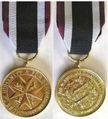
Miss Nora Fletcher, R.R.C., of Sydney, has, according to advices just received from London, been decorated with the honorary serving sister grade of the Order of St. John of Jerusalem in England, for her services in France and Belgium with British Red Cross and Order of St. John. Sister Fletcher was mentioned in despatches, and received the Royal Red Cross (first class) on the occasion of the birthday honours in 1915.
Sydney Morning Herald Wednesday 18 October 1916 page 10
Sydney Morning Herald Wednesday 18 October 1916 page 10
In a recent issue of the Sydney Daily Telegraph appeared a photograph of an Australian nurse, Miss Nora Fletcher, who has gained great distinction during the war. The photograph portrays Miss Fletcher in her nurse's uniform, the face, which is strikingly interesting looking, is full of strength, purpose, and gentleness, and with the soft, half-sad expression so often seen in the true born nurse. Like so many nurses, she has done very fine work since the outbreak of war. According to the "Daily Telegraph," Miss Fletcher is a Sydney born woman, the daughter of Mr. and Mrs. W. T. W. Fletcher, of Neutral Bay. She was trained at the Coast Hospital, Sydney, and afterwards went to England,where she was at the time war broke out, when she offered her services and was sent by the Red Cross Society to France. She was appointed matron of the British Red Cross, and she received recognition from the French Government, and afterwards was decorated by the British Government. Later she was mentioned in despatches for her services, and was among the recipients of the King's Birthday honours, being the recipient of the highest honour possible to women, the Royal Red Cross which His Majesty bestowed upon her at Buckingham Palace. Evidently Australia may yet be as proud of her daughters as she so justly is of her sons, who have earned the admiration and praise of the civilised world for the part they are playing in the great and terrible war now raging, and in which they are so ready to serve in defence of our Empire and all that is right and just.
The Land Friday 17 March 1916 page 10
The Land Friday 17 March 1916 page 10
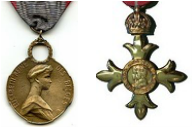
Miss Nora Fletcher, of Sydney, who was matron-ln-chief of the British Red Cross in France and Belgium, has added C. B. E. to her other orders and decorations, and must now have every honor, it is possible for a nurse to win , including the Royal Red Cross, the Order of St. John of Jerusalem, the Belgian Order of Elizabeth, the French Order of Gratitude, the 1914 Star, and the various war medals.
The Daily News Wednesday 09 June 1920 page 3
The Daily News Wednesday 09 June 1920 page 3
Miss-Nora Fletcher, the Queensland lady Who was Matron-in-chief of the Royal Red Cross in France during the war, was invested with the C.B.E. at Buckingham Palace this week. She is entitled to wear nine medals and innumerable letters after her name.
The Australasian Saturday 21 May 1921 page 42
The Australasian Saturday 21 May 1921 page 42
FLETT, Evelyn Gertrude
Staff Nurse
AANS
Born 09 November 1887 at South Shields, England
Occupation prior to enlistment Nurse
Enlisted 08 November 1917
Aged 29 years
Embarked 14 November 1917 per 'Indarra' from Melbourne, Vic.
Served in India
Returned to Australia 14 September 1919 per 'Port Lincoln'
Appointment terminated 20 May 1920
AANS
Born 09 November 1887 at South Shields, England
Occupation prior to enlistment Nurse
Enlisted 08 November 1917
Aged 29 years
Embarked 14 November 1917 per 'Indarra' from Melbourne, Vic.
Served in India
Returned to Australia 14 September 1919 per 'Port Lincoln'
Appointment terminated 20 May 1920
FLOREY, Annie/Ann Julia
Sister
Queen Alexandra's Imperial Military Nursing Service Reserve
Born 1880 in England
Daughter of Joseph FLOREY and Bertha Mary nee WADHAM
Sister of Sir Howard FLOREY
Appointed to QAIMNSR 02 April 1915
17 May 1916 to Bombay per 'Dengola'
18 June 1916 Joined for duty at Amarah
01 July 1917 On River Convoy duty P 51
22 July 1917 Rejoined from Dett duty
10 September 1917 Effective with Unit Amarah
28 October 1917 Posted to Baghdad for duty
04 November 1917 Joined for duty at Baghdad
25 June 1917 Awarded Royal Red Cross 2nd Class
15 August 1917 Mentioned in despatches Lt. Sir Stanley Maude K.C.B.
17 January 1918 Admitted to hospital in Baghdad
28 January 1918 Discharged to duty
09 February 1918 Proceeded to India per H.T. Janus contract expired
Returned to UK 29 May 1918 per 'Dunluce Castle'
'Sister Anne Julia Florey has served under me for the last three months. I consider her a thoroughly well trained nurse, tactful, most reliable and good tempered, she possesses good sound common sense, her powers of administration are excellent with far above the average of her rank. She takes an interest in training her orderlies.'
Appointment terminated 30 May 1918
Applied for assisted passage return to home back in Adelaide 22 October 1919
Residing at Bungalow, West Clandon, Surrey, England
Matron at Abington Public School in England in the 1940's
Did not marry
Died 1962 in Hawthorn, Vic.
Buried 02 March 1962 Springvale Botanical Cemetery Dodonaea, Colonnade 3, Section P Niche 41
Queen Alexandra's Imperial Military Nursing Service Reserve
Born 1880 in England
Daughter of Joseph FLOREY and Bertha Mary nee WADHAM
Sister of Sir Howard FLOREY
Appointed to QAIMNSR 02 April 1915
17 May 1916 to Bombay per 'Dengola'
18 June 1916 Joined for duty at Amarah
01 July 1917 On River Convoy duty P 51
22 July 1917 Rejoined from Dett duty
10 September 1917 Effective with Unit Amarah
28 October 1917 Posted to Baghdad for duty
04 November 1917 Joined for duty at Baghdad
25 June 1917 Awarded Royal Red Cross 2nd Class
15 August 1917 Mentioned in despatches Lt. Sir Stanley Maude K.C.B.
17 January 1918 Admitted to hospital in Baghdad
28 January 1918 Discharged to duty
09 February 1918 Proceeded to India per H.T. Janus contract expired
Returned to UK 29 May 1918 per 'Dunluce Castle'
'Sister Anne Julia Florey has served under me for the last three months. I consider her a thoroughly well trained nurse, tactful, most reliable and good tempered, she possesses good sound common sense, her powers of administration are excellent with far above the average of her rank. She takes an interest in training her orderlies.'
Appointment terminated 30 May 1918
Applied for assisted passage return to home back in Adelaide 22 October 1919
Residing at Bungalow, West Clandon, Surrey, England
Matron at Abington Public School in England in the 1940's
Did not marry
Died 1962 in Hawthorn, Vic.
Buried 02 March 1962 Springvale Botanical Cemetery Dodonaea, Colonnade 3, Section P Niche 41

Mentioned in Despatches
Date of Commonwealth of Australia Gazette: 21 September 1916
Location in Commonwealth of Australia Gazette: Page 2624, position 71
Date of London Gazette: 21 June 1916
Location in London Gazette: Page 6184, position 63
Date of Commonwealth of Australia Gazette: 21 September 1916
Location in Commonwealth of Australia Gazette: Page 2624, position 71
Date of London Gazette: 21 June 1916
Location in London Gazette: Page 6184, position 63

Awarded Royal Red Cross 2nd Class
25 June 1917
25 June 1917
FLOWER, Linda
Sister
AANS
Born 1885 at Brunswick, Vic.
Daughter of Frederick FLOWER and Mary Ellen nee WILLIAMS
Of 7 Stewart Street, Williamstown, Vic.
Occupation prior to enlistment Nurse
Enlisted 20 July 1915
Aged 30 years
Embarked 21 August 1915
Served in England and France
Returned to Australia 14 May 1919 per 'City of Poona'
Appointment terminated 02 October 1919
Did not marry
Died 19 March 1962 at Heidelberg, Vic.
Resided Brighton, Vic.
Buried 21 March 1962 Springvale Botanical Cemetery Boronia Wall X, Niche 154
AANS
Born 1885 at Brunswick, Vic.
Daughter of Frederick FLOWER and Mary Ellen nee WILLIAMS
Of 7 Stewart Street, Williamstown, Vic.
Occupation prior to enlistment Nurse
Enlisted 20 July 1915
Aged 30 years
Embarked 21 August 1915
Served in England and France
Returned to Australia 14 May 1919 per 'City of Poona'
Appointment terminated 02 October 1919
Did not marry
Died 19 March 1962 at Heidelberg, Vic.
Resided Brighton, Vic.
Buried 21 March 1962 Springvale Botanical Cemetery Boronia Wall X, Niche 154
FLOWER, Madge Earle
Sister
AANS
Born 'Maggie Earle FLOWER' 1883 at Clunes, Vic.
Daughter of Mr. Frederick FLOWER and May Ellen nee WILLIAMS
Of 17 Stewart Street, Williamstown, Vic.
Occupation prior to enlistment Nurse
Enlisted 25 April 1917
Aged 29 years
Embarked 21 April 1917 from Melbourne, Vic.
Served in France
Returned to Australia 06 May 1920 per 'Ceramic'
Appointment terminated 17 July 1920
Did not marry
Died 27 October 1963 in Heidelberg, Vic.
Resided Camberwell, Vic.
Buried Williamstown Cemetery 27 October 1963
AANS
Born 'Maggie Earle FLOWER' 1883 at Clunes, Vic.
Daughter of Mr. Frederick FLOWER and May Ellen nee WILLIAMS
Of 17 Stewart Street, Williamstown, Vic.
Occupation prior to enlistment Nurse
Enlisted 25 April 1917
Aged 29 years
Embarked 21 April 1917 from Melbourne, Vic.
Served in France
Returned to Australia 06 May 1920 per 'Ceramic'
Appointment terminated 17 July 1920
Did not marry
Died 27 October 1963 in Heidelberg, Vic.
Resided Camberwell, Vic.
Buried Williamstown Cemetery 27 October 1963
FLOWER, Vera Emily
Staff Nurse
AANS
Born Bega, NSW
Daughter of Frederick Gregg FLOWER
Of 'Gunawah', Bangalow, NSW
Occupation prior to enlistment Nurse
Enlisted 08 July 1915
Aged 28 years
Embarked 14 July 1915
Served in France
Appointment terminated due to marriage in England 08 August 1917
Married Foxton W HAYLEY
Died 16 June 1970
Late of Lismore, NSW
The wedding was celebrated on August 8, at St. Peter's, Bayswater, of Captain Foxton W. Hayley, Australian Field Ambulance, and Sister Vera E. Flower., A.A.N.S. Sister Dickson, A.A.N.S., was bridesmaid, and Lieutenant W. E. Robinson, A.I.F., grooms-man, while Major Lethbridge, A.I.F., gave the bride away. It was an entirely Australian ceremony. Chaplain Captain H. B. Blackwood, on leave from France, was the officiating clergyman, assisted by the Rev. Mr. Norman. Solos were rendered by Miss Ethel Williamson (N.S.W.) and Private E. Carr Cameron, A.I.F. Private Dalby Scarlett, A.I.F., presided at the organ. A reception was held by Mrs. E. Clive Williamson (N.S.W)., aunt of the bridegroom, at Victoria House, 15 Pembridge-square, W.
The Daily News Thursday 22 November 1917 page 3
AANS
Born Bega, NSW
Daughter of Frederick Gregg FLOWER
Of 'Gunawah', Bangalow, NSW
Occupation prior to enlistment Nurse
Enlisted 08 July 1915
Aged 28 years
Embarked 14 July 1915
Served in France
Appointment terminated due to marriage in England 08 August 1917
Married Foxton W HAYLEY
Died 16 June 1970
Late of Lismore, NSW
The wedding was celebrated on August 8, at St. Peter's, Bayswater, of Captain Foxton W. Hayley, Australian Field Ambulance, and Sister Vera E. Flower., A.A.N.S. Sister Dickson, A.A.N.S., was bridesmaid, and Lieutenant W. E. Robinson, A.I.F., grooms-man, while Major Lethbridge, A.I.F., gave the bride away. It was an entirely Australian ceremony. Chaplain Captain H. B. Blackwood, on leave from France, was the officiating clergyman, assisted by the Rev. Mr. Norman. Solos were rendered by Miss Ethel Williamson (N.S.W.) and Private E. Carr Cameron, A.I.F. Private Dalby Scarlett, A.I.F., presided at the organ. A reception was held by Mrs. E. Clive Williamson (N.S.W)., aunt of the bridegroom, at Victoria House, 15 Pembridge-square, W.
The Daily News Thursday 22 November 1917 page 3
FLYNN, Julia
Nurse Julia Flynn, who offered her services for the front and has been accepted, is a Townsville girl and was trained in the Townsville Hospital. Nurse Flynn left on Monday evening for the south.
Townsville Daily Bulletin Wednesday 06 June 1917 page 4
Townsville Daily Bulletin Wednesday 06 June 1917 page 4
FOGARTY, Loretto Johanna/Josephine
|
Sister
Queen Alexandra's Imperial Military Nursing Service Reserve Born 05 March 1887 at Williamstown, Vic. Daughter of Patrick Alexander FOGARTY and Mary Ann Josephine nee GLEESON Of 'Tequila' Doncaster Road, Balwyn, Melbourne, Vic. Trained Royal Melbourne Hospital January 1908 to February 1911 Embarked for England 27 February 1915 at own expense per 'Ballarat' from Melbourne, Vic. - amount compensated in 1920 Arrived in London 18 April 1915 Appointed to QAIMNSR 22 May 1915 Served in Salonika at 49th and 43rd General Hospitals Transferred from Dublin to Netley 19 January 1917 Report from Major at Dublin 'I am directed to inform you that miss L.J. Fogarty, Sister, Queen Alexandria's Imperial Military Nursing Service Reserve was reported by the Matron (Farley) at Dublin to have 'lost all interest in her work, since her return from leave; to have neglected to look after the cleanliness and good order of her wards, loans, accidentals and equipment. She resented her attention being called to these facts, and her attitude became hostile, her manner insubordinate, her influence and example in quarters and hospital very bad and subversive to discipline.' In forwarding this report the Officer in charge recommended Miss Fogarty's transfer to another station, and expressed the opinion that Miss Fogarty's conduct was not conducive to discipline or harmony. Miss Fogarty was, in accordance with this recommendation transferred to Netley on 16th January 1917. In this Office letter of that date the rank of this lady was given in error as Staff Nurse, there was no intention of reducing Miss Fogarty in rank, this error would have been remedied at once had it been pointed out. I am to request that the Matron of the Royal Victoria Hospital, Netley, may be asked to furnish a report now on Miss L. Fogarty's suitability in all respects for retention in the Service, and for the rank of Sister.' Report from Matron of Royal Victoria Hospital Netley 18 May 1917 - 'Miss L.J. Fogarty has worked under my personal observation since 21st January 1917. She has had charge of two surgical wards (32 beds) under the supervision of a senior sister. On first taking up her duties it was evident that she lacked experience in ward management, and had not a sufficient knowledge of the routine procedure in checking and replacing unserviceable articles of equipment etc., to enable her to carry out the duties of a Sister in charge of a division. She has shown herself anxious to become efficient, and has kept her wards in good order, her professional work has been quite satisfactory, and her conduct exemplary. Judging Miss Fogarty by her work and behaviour while serving at this station, she is suitable for retention in the Service, but I consider that she requires still further experience to fit her for the duties of a Senior Sister.' Embarked for Salonika 08 March 1918 Awarded Royal Red Cross 2nd Class 01 January 1919 Arrived at Sisters Convalescent Homes Bebek 13 December 1919 with 'ICT Thigh Right' Embarked for UK 18 December 1919 Demobilised 06 January 1920 Resided South Infirmary & County Hospital, Co Cork, Ireland in January 1920 awaiting passage to Melbourne, Australia Returned to Australia 20 March 1920 per 'Ormonde' Died 29 May 1977 at Surrey Hills, Vic. Aged 91 years Resided Surrey Hills, Vic. Late of RSL House, St. Kilda, Vic. |

Awarded Royal Red Cross 2nd Class
01 January 1919
01 January 1919
FOGELIN, Svea Marie Victoria
Staff Nurse
New Zealand Forces
Born 1883 at Newtown, NSW
Daughter of Charles/Carl Augustus and Anna Sophia Wilhelmina FOGELIN
Seriously Ill with Pneumonia
Did not marry
Died 30 November 1951 at her residence 75 High Street, Willoughby, NSW
Aged 67 years
Funeral at Northern Suburbs Crematorium
New Zealand Forces
Born 1883 at Newtown, NSW
Daughter of Charles/Carl Augustus and Anna Sophia Wilhelmina FOGELIN
Seriously Ill with Pneumonia
Did not marry
Died 30 November 1951 at her residence 75 High Street, Willoughby, NSW
Aged 67 years
Funeral at Northern Suburbs Crematorium
UPDATED ON VWMA TO HERE
FOLDER, Muriel/Mabel
|
Staff Nurse
AANS Born 14 June 1887 at Port Cygnet, Tasmania Daughter of William FOLDER and Catherine nee HALTON Sister of Gertrude RICHARDSON Of 26 Crowall St., Battery Point, Hobart, Tas. Occupation prior to enlistment Nurse Trained at Hobart General Hospital Enlisted 31 May 1917 at Claremont, Tasmania Aged 30 years Served in Salonika Returned to Australia 26 February 1920 per 'Themistocles' Appointment terminated 17 April 1920 Sister at Repatriation Hospital, Hobart and principal Matron of the Army Nursing Service in Tasmania in 1937 Did not marry Died 30 November 1964 Aged 78 years Resided Dynnyrne, Tas. Buried Cornelian Bay Cemetery Roman Catholic ND 357 |
FOLEY, Grace KathleenStaff Nurse
AANS Born 1890 in Kew Vic. Daughter of William FOLEY and Mary nee O'SHAUGHNESSY Of O'Shaughnessy Street, Kew, Vic. Occupation prior to enlistment Nurse Enlisted 28 May 1917 Aged 27 years Embarked at Melbourne 12 June 1917 per 'Mooltan' Served in Salonika Returned to Australia per 'Ulysses' 15 February 1918 Did not marry Died suddenly 30 September 1938 at Studley Park Road, Kew Resided Kew, Vic. Buried 01 October 1938 Boroondara General Cemetery RC B 0028 |
FOLLINGTON, Emily Eugenie
Staff Nurse
AANS
3rd A G H
Born 1892 in Ryde, NSW
Daughter of Edward John FOLLINGTON and Amelia nee BOOTH
Of 'Rydal' Spearwood, WA
Occupation prior to enlistment Certificated Nurse
Enlisted No 8 Australian General Hopsital, Fremantle, WA on 08 May 1917
Aged 24 years
Embarked at Fremantle 19 May 1917 per 'Benalla'
Served in England
Returned to Australia 03 March 1919 per 'Ceramic'
Appointment terminated 16 November 1919
Married Robert DAVIDSON in 1922
Resided Mount Lawley, WA
Died 13 December 1971 in Perth, WA
Aged 79 years
Ashes scattered at Karrakatta Cemetery, WA
AANS
3rd A G H
Born 1892 in Ryde, NSW
Daughter of Edward John FOLLINGTON and Amelia nee BOOTH
Of 'Rydal' Spearwood, WA
Occupation prior to enlistment Certificated Nurse
Enlisted No 8 Australian General Hopsital, Fremantle, WA on 08 May 1917
Aged 24 years
Embarked at Fremantle 19 May 1917 per 'Benalla'
Served in England
Returned to Australia 03 March 1919 per 'Ceramic'
Appointment terminated 16 November 1919
Married Robert DAVIDSON in 1922
Resided Mount Lawley, WA
Died 13 December 1971 in Perth, WA
Aged 79 years
Ashes scattered at Karrakatta Cemetery, WA
FORBES, Beatrice Vera
Staff Nurse
AANS
Born 1887 at Colac, Vic
Daughter of Ernest FORBES and Annie Elizabeth nee McCURE
Of 'Laugana' Colac, Vic.
Occupation prior to enlistment Nurse
Enlisted 27 April 1917
Aged 29 years
Embarked from sydney 09 May 1917
Served in England
Returned to Australia 14 June 1918 per 'Tofua'
Appointment terminated 17 August 1918
Married Dr. Egbert John CONNELL
Died 17 March 1972 in Geelong, Vic.
Resided Newtown, Vic.
AANS
Born 1887 at Colac, Vic
Daughter of Ernest FORBES and Annie Elizabeth nee McCURE
Of 'Laugana' Colac, Vic.
Occupation prior to enlistment Nurse
Enlisted 27 April 1917
Aged 29 years
Embarked from sydney 09 May 1917
Served in England
Returned to Australia 14 June 1918 per 'Tofua'
Appointment terminated 17 August 1918
Married Dr. Egbert John CONNELL
Died 17 March 1972 in Geelong, Vic.
Resided Newtown, Vic.
FORD, Helen Blanche
Staff Nurse
AANS
Born 1874 in Bathurst, NSW
Daughter of Mark Edward Dyett FORD and Edna Keaquick Rose nee HOLDER
Sister of Albine Edna TERRY
Of 'Collingswood', Hurstville, Sydney, NSW
Occupation prior to enlistment Nurse
Enlisted 26 April 1915
Aged 39 years
Embarked 15 May 1915
Served in England and France
Returned to Australia 28 September 1918 per 'Malta'
Discharged as medically unfit 25 December 1918
Married Harry Ninham GOOCH 1921 in NSW
Died 16 May 1944 at home in Mosman, NSW
Late of Mosman, NSW
Privately Cremated
GOOCH.-May 16. 1944, at her residence Mosman. Helen Blanche (Sister Ford. A.A.N.S..1st A.I.F.). wile of H. N Gooch. Privately cremated May 17. 1944.
AANS
Born 1874 in Bathurst, NSW
Daughter of Mark Edward Dyett FORD and Edna Keaquick Rose nee HOLDER
Sister of Albine Edna TERRY
Of 'Collingswood', Hurstville, Sydney, NSW
Occupation prior to enlistment Nurse
Enlisted 26 April 1915
Aged 39 years
Embarked 15 May 1915
Served in England and France
Returned to Australia 28 September 1918 per 'Malta'
Discharged as medically unfit 25 December 1918
Married Harry Ninham GOOCH 1921 in NSW
Died 16 May 1944 at home in Mosman, NSW
Late of Mosman, NSW
Privately Cremated
GOOCH.-May 16. 1944, at her residence Mosman. Helen Blanche (Sister Ford. A.A.N.S..1st A.I.F.). wile of H. N Gooch. Privately cremated May 17. 1944.
FOREMAN, Kate Alice
aka GREGG, Kate
|
Staff Nurse
AANS 2nd Aust. General Hosptial Born 1888 in Hobart, Tasmania Daughter of Richard FOREMAN and Kate nee JILLETT Of Marrickville Road, Marrickville, NSW Occupation prior to enlistment Nurse Enlisted 14 July 1915 Aged 27 years 9 months Embarked from Sydney per 'Orsova' 10 October 1915 Served in France Returned to Australia 27 December 1918 per 'Sardinia' Resigned appointment in England due to marriage 03 September 1918 Married Beaufort GREGG in England in 1918 Died 10 August 1971 in Armidale, NSW Aged 83 years Formerly of Wee Waa, Gilgandra, Blackheath and Bathurst, NSW |
FORLONGE, Marion Constance
Sister
AANS
Born 1882 in Condoblin, NSW
Daughter of Charles Henry FORLONGE and Sarah nee LANE
Of Commercial Bank, West Dempsey, NSW
Occupation prior to enlistment Nurse
Enlisted 16 January 1917
Aged 28 years
Embarked from Melbourne 31 August 1917 per 'Wiltshire'
Served in Salonika
Returned to Australia 11 September 1919 per 'Canberra'
Appointment terminated 19 December 1919
Married Charles G CARR-BOYD in 1922
Resided Court House, Bega NSW in 1923
Died 30 April 1969 in Newcastle, NSW
Late of Newcastle, NSW
WELCOME HOME.
On Tuesday evening the Condobolin Coo-ee Girls are extending a welcome home to Nurse Connie Forlonge, a sister of Mr Charles Forlonge of this town, who has just returned to Condobolin after an absence of over two and a half years nursing in Egypt and Palestine.
Forbes Advocate Friday 5 December 1919 page 3
AANS
Born 1882 in Condoblin, NSW
Daughter of Charles Henry FORLONGE and Sarah nee LANE
Of Commercial Bank, West Dempsey, NSW
Occupation prior to enlistment Nurse
Enlisted 16 January 1917
Aged 28 years
Embarked from Melbourne 31 August 1917 per 'Wiltshire'
Served in Salonika
Returned to Australia 11 September 1919 per 'Canberra'
Appointment terminated 19 December 1919
Married Charles G CARR-BOYD in 1922
Resided Court House, Bega NSW in 1923
Died 30 April 1969 in Newcastle, NSW
Late of Newcastle, NSW
WELCOME HOME.
On Tuesday evening the Condobolin Coo-ee Girls are extending a welcome home to Nurse Connie Forlonge, a sister of Mr Charles Forlonge of this town, who has just returned to Condobolin after an absence of over two and a half years nursing in Egypt and Palestine.
Forbes Advocate Friday 5 December 1919 page 3
FORREST, Eliza Annetta (Netta)
Staff Nurse
Queen Alexandra's Imperial Military Nursing Service Reserve
Queen Alexandra's Imperial Military Nursing Service Reserve
DISTINGUISHED HONOR WON BY BEECHWORTH LADY.
Nurse Netta Forrest, daughter of Mr. B. E. Forrest of Beechworth, is returning to Australia this month, after four years' service as a military nurse at the front, where she did magnificent work. On 14th June, prior to leaving for Australia, she was invested by the King at Buckingham Palace, with the R.R.C. (Royal Red Cross) was presented to Queen Alexander at Marlborough House, who thanked her personally for the service rendered to the wounded soldiers. Nurse Forrest is a native of Beechworth, and everyone rejoices that her noble conduct has been suitably acknowledged by the English nation.
Wodonga and Towong Sentinel Friday 15 August 1919 page 2
Nurse Netta Forrest, daughter of Mr. B. E. Forrest of Beechworth, is returning to Australia this month, after four years' service as a military nurse at the front, where she did magnificent work. On 14th June, prior to leaving for Australia, she was invested by the King at Buckingham Palace, with the R.R.C. (Royal Red Cross) was presented to Queen Alexander at Marlborough House, who thanked her personally for the service rendered to the wounded soldiers. Nurse Forrest is a native of Beechworth, and everyone rejoices that her noble conduct has been suitably acknowledged by the English nation.
Wodonga and Towong Sentinel Friday 15 August 1919 page 2
FORSTER, Mary
Staff Nurse
Queen Alexandra's Imperial Military Nursing Reserve
Bridesmaid to Blanche Mary Fowler
Queen Alexandra's Imperial Military Nursing Reserve
Bridesmaid to Blanche Mary Fowler
FORSYTH, Ethel Lillian
|
Sister
AANS Born Mansfield, Vic Daughter of Mrs. Barbara FORSYTH Sister to Florence Constance FORSYTH - AANS Address “Maitoongoon”, Mansfield, Vic Training 3 years Melbourne Hospital, Vic Age 31 years Enlisted 05 November 1914 Embarked 28 November 1914 Was on the first Hospital Ship to arrive at Gallipoli in 1915 and was on the last one to leave. She was the only Australian Army Nursing Sister to be awarded the Gallipoli Medal. Service in Egypt, England and France Promoted to Sister 01 December 1915 Returned to Australia per “Karmala” 02 January 1919 Appointment Terminated 19 April 1919 Did not marry Living at Lady Davidson Home, Turramurra, NSW on 18 June 1940 Died 30 July 1977 Late of Camberwell, NSW Photograph Mansfield's Souvenir of the War 1914-1919 Punch Thursday 03 December 1914 page 26 |
FORSYTH, Florence Constance
Staff Nurse
AANS
Born 1885 in Mansfield, Vic
Daughter of James FORSYTH and Barbara nee MATTHEWSON
Sister to Ethel Lillian FORSYTH - AANS
Address “Maitoongoon”, Mansfield, Vic
Training 3 years Melbourne Hospital, Vic
Age 31 years
Enlisted 08 November 1917
Embarked 26 November 1917 per “Indarra” in Melbourne
Service in India
Returned to Australia per “City of Cairo” 28 February 1919
Appointment Terminated 07 June 1919
Living in Honolulu by 22 September 1924
Did not marry
Died 17 November 1962 in Richmond, Vic.
Resided North Balwyn, Vic.
Cremated Springvale Botanical Cemetery and ashes scattered
AANS
Born 1885 in Mansfield, Vic
Daughter of James FORSYTH and Barbara nee MATTHEWSON
Sister to Ethel Lillian FORSYTH - AANS
Address “Maitoongoon”, Mansfield, Vic
Training 3 years Melbourne Hospital, Vic
Age 31 years
Enlisted 08 November 1917
Embarked 26 November 1917 per “Indarra” in Melbourne
Service in India
Returned to Australia per “City of Cairo” 28 February 1919
Appointment Terminated 07 June 1919
Living in Honolulu by 22 September 1924
Did not marry
Died 17 November 1962 in Richmond, Vic.
Resided North Balwyn, Vic.
Cremated Springvale Botanical Cemetery and ashes scattered
FOSTER, Edith Annie
|
Sister
AANS Born c1875 in London, England Daughter of Charles FOSTER and Anne Footner nee STANDEN Age 38 years Enlisted 24 November 1914 Embarked 25 November 1914 Service England and on the field in France Promoted to Sister 01 December 1915 Returned to Australia 12 December 1918 per “Nestor” Appointment terminated 15 April 1919 Did not marry Died 24 May 1949 at Home of Peach Late of Dover Heights, NSW Aged 74 years Resided Foster Heights, NSW www.awm.gov.au J06858 |
FOSTER, Edith Vera Irene
|
Staff Nurse
AANS Born 30 January 1888 at Rendelsham, SA Daughter of William FOSTER and Elizabeth nee CHAMPION of Parkside SA Age 29 years Training Adelaide Hospital Enlisted 11 September 1917 at Keswick Embarked 09 November 1918 in Sydney per “Wiltshire” Service in India and Afghanistan border Returned to Australia 09 November 1918 per “Kashgar” Appointment terminated 11 February 1920 Married Martin TRUDINGER 21 January 1921 at Methodist Church, Kent Town, SA Had a family of 2 daughters Suffered from Paralysis Agitans for 12 years Died 03 July 1953 at The Home for Incurables, Fullarton, SA Aged 65 years Resided Fullarton, SA Buried Centennial Park Cemetery |
FOWLER, Blanche Mary
Sister
Queen Alexandra's Imperial Military Nursing Service Reserve
Born 1884 in Williamstown, Vic.
Daughter of Alfred FOWLER and Jane Dunnet nee DOULL
Of Williamstown, Vic.
Married Commander Vaughan Alexander Edward HANNING-LEE
Died Isle of Wight 1958
"Naval Engagement"
IN THE MEDITERRANEAN.
The engagement is announced, and the marriage will shortly take place abroad, of Sister Blanche Mary Fowler, Q.A.I.M.N.S.R., second daughter of Mr and Mrs Alfred Fowler, of "Korioga," Verdon street, and Commander Vaughan Hanning-Lee, of H.M.S, "Ladybird," eldest son of the late Colonel Hanning-Lee, formerly in command of the 2nd Life Guards.
Williamstown Advertiser Saturday 27 January 1917 page 3
A NAVAL MARRIAGE.
COMMANDER VAUGHAN HANNING-LEEI TO MISS BLANCHE M. FOWLER.
An interesting wedding took place on Friday, 26th. January, at the Garrison Church of St. John's in the Wilderness, Ismailia, between Miss Blanche Mary Fowler, eldest daughter of Mr. Alfred Fowler, of Williamstown, Australia, and Commander Yaughan Hanning-Lee, Royal Navy, eldest son of the late Colonel Hanning-Lee, 2nd Life Guards,of Old Manor House, Brighton, Alresford, Hants., England. The Rev. Canon Hichens, C.F., officiated. The bride, who was beautifully dressed in white charmeuse and carried a bouquet of roses, was given away by Lieut.-Col. Gwynn, R.A.M.C., of the 26th Stationary Hospital. The two bridesmaids were Miss Mary Foster and Miss Amy Bridson, of the Q.A.I.M.N.S.R. The bridegroom was attended by Surgeon J. Hadwen, R.N., as best man.
The church was prettily decorated with palms and flowers presented by the Suez Canal Company. Owing to the fact that the bridegroom was in mourning for his father, the wedding was of a very quiet character, and the guests were limited to about fifty personal friends of the bride and bridegroom. Among those present were Vice-Admiral Sir Roslyn Wemyss, K.C.B.; Captain MacDonald, R.N.; Commander Marriott, R.N.; Commander Betts, R.N., and other naval and military officers ; Miss German, matron of the 26th Stationary Hospital, and some Nursing Sisters. Outside the church was a guard of honour formed by Bluejackets from the bridegroom's ship. After the service the Vice-Admiral gave a reception and luncheon at Admiralty House, where he asked the guests to drink to the brides "joining the Navy." "Australia," he said, "had given generously in men and money, and now she was giving one of her fair daughters." Following a time-honoured custom, the bride cut the cake with her husband sword. Commander and Mrs. Hanning-Lee left later for Cairo and Luxor.
Punch Thursday 12 April 1917 page 29
Queen Alexandra's Imperial Military Nursing Service Reserve
Born 1884 in Williamstown, Vic.
Daughter of Alfred FOWLER and Jane Dunnet nee DOULL
Of Williamstown, Vic.
Married Commander Vaughan Alexander Edward HANNING-LEE
Died Isle of Wight 1958
"Naval Engagement"
IN THE MEDITERRANEAN.
The engagement is announced, and the marriage will shortly take place abroad, of Sister Blanche Mary Fowler, Q.A.I.M.N.S.R., second daughter of Mr and Mrs Alfred Fowler, of "Korioga," Verdon street, and Commander Vaughan Hanning-Lee, of H.M.S, "Ladybird," eldest son of the late Colonel Hanning-Lee, formerly in command of the 2nd Life Guards.
Williamstown Advertiser Saturday 27 January 1917 page 3
A NAVAL MARRIAGE.
COMMANDER VAUGHAN HANNING-LEEI TO MISS BLANCHE M. FOWLER.
An interesting wedding took place on Friday, 26th. January, at the Garrison Church of St. John's in the Wilderness, Ismailia, between Miss Blanche Mary Fowler, eldest daughter of Mr. Alfred Fowler, of Williamstown, Australia, and Commander Yaughan Hanning-Lee, Royal Navy, eldest son of the late Colonel Hanning-Lee, 2nd Life Guards,of Old Manor House, Brighton, Alresford, Hants., England. The Rev. Canon Hichens, C.F., officiated. The bride, who was beautifully dressed in white charmeuse and carried a bouquet of roses, was given away by Lieut.-Col. Gwynn, R.A.M.C., of the 26th Stationary Hospital. The two bridesmaids were Miss Mary Foster and Miss Amy Bridson, of the Q.A.I.M.N.S.R. The bridegroom was attended by Surgeon J. Hadwen, R.N., as best man.
The church was prettily decorated with palms and flowers presented by the Suez Canal Company. Owing to the fact that the bridegroom was in mourning for his father, the wedding was of a very quiet character, and the guests were limited to about fifty personal friends of the bride and bridegroom. Among those present were Vice-Admiral Sir Roslyn Wemyss, K.C.B.; Captain MacDonald, R.N.; Commander Marriott, R.N.; Commander Betts, R.N., and other naval and military officers ; Miss German, matron of the 26th Stationary Hospital, and some Nursing Sisters. Outside the church was a guard of honour formed by Bluejackets from the bridegroom's ship. After the service the Vice-Admiral gave a reception and luncheon at Admiralty House, where he asked the guests to drink to the brides "joining the Navy." "Australia," he said, "had given generously in men and money, and now she was giving one of her fair daughters." Following a time-honoured custom, the bride cut the cake with her husband sword. Commander and Mrs. Hanning-Lee left later for Cairo and Luxor.
Punch Thursday 12 April 1917 page 29
FRANCIS, Ida Grace
|
Staff Nurse
AANS Born 1891 in Bega, NSW Daughter of Evan FRANCIS and Sarah Ann nee SPENCE Age 25 years Enlisted 25 February 1916 Embarked 29 December 1916 in Sydney per “Themistocles” Service England and France Returned to Australia 08 January per “Orsova” On Duty Appointment terminated 06 April 1919 Did not marry Died 1959 in Qld. |
Sister I. G. Francis, late of the A.I.F., has taken up duty as matron of the Tambo District Hospital.
The Brisbane Courier Friday 16 January 1920 page 7
MATRON of her own hospital in Maryborough, Queensland.
Miss Grace Francis has had an interesting career in her profession.
"I simply had to be a nurse," she said. "I come of a family of nurses, there being six trained nurses in a family of seven." Miss Francis trained at the Gympie Hospital. She served abroad with the Army over two years, and
after that was matron of the Tambo Hospital for a time. Joining the Australian Inland Mission, Miss Francis was stationed at Birdsville and Victoria Downs during her four years' service. Later, with three of her sisters, she purchased St. Mary's Hospital, Maryborough, which is now a training school for nurses.
The Australian Women's Weekly Saturday 27 August 1938 page 41
The Brisbane Courier Friday 16 January 1920 page 7
MATRON of her own hospital in Maryborough, Queensland.
Miss Grace Francis has had an interesting career in her profession.
"I simply had to be a nurse," she said. "I come of a family of nurses, there being six trained nurses in a family of seven." Miss Francis trained at the Gympie Hospital. She served abroad with the Army over two years, and
after that was matron of the Tambo Hospital for a time. Joining the Australian Inland Mission, Miss Francis was stationed at Birdsville and Victoria Downs during her four years' service. Later, with three of her sisters, she purchased St. Mary's Hospital, Maryborough, which is now a training school for nurses.
The Australian Women's Weekly Saturday 27 August 1938 page 41
|
WELL DESERVED HONOURS
Another well-merited honour is the MBE bestowed on Miss Ida Grace Francis, of Surfer's Paradise, who with another nurse opened the first Australian Inland 'Mission home at Birdsville and later served at Victoria River Downs. She was a nurse in France in the first world war, and was Maryborough V.A.D. Commandant in the second. She is now on the committee of Queensland Bush Children's ' Health Scheme. Queensland Country Life Thursday 15 June 1950 page 8 |
FRANCIS, Ruth Sylvia
|
Staff Nurse
AANS Born 1885 in Bega, NSW Daughter of Evan FRANCIS and Sarah Ann nee SPENCE Age 31 years Enlisted 15 November 1916 Embarked 09 May 1917 in Sydney per “Ulysses” Service England and France Contracted Influenza October 1918 Returned to Australia 08 January 1919 per “Orsova” Appointment terminated 30 March 1919 Married Horace Bruce ROCKWELL in 1920 Died 31 May 1961 in Chatswood, NSW The Queenslander Saturday 06 July 1918 page 28 |
FRANCIS, Sara StellaStaff Nurse
AANS Born 1889 in Bega, NSW Daughter of Evan FRANCIS and Sarah Ann nee SPENCE Aged 26 years Enlisted 25 August 1916 at Brisbane, Qld. Embarked 16 September 1916 in Sydney per “Karmala” Service India, Egypt and England Promoted to Sister 25 September 1918 Returned to Australia 04 July 1919 per “Norman” Appointment terminated 06 October 1919 Did not marry Died 17 August 1969 in Qld. Aged 80 years Late of Toowong, Qld. Buried Mount Thompson Memorial Gardens Columbarium 32 Section 12 |
FRANKLIN, Stella Miles
|
Scottish Women's Hospitals for Foreign Service
Born 1879 at Talbingo, NSW Miles Franklin was an orderly in the Scottish Women’s Hospital, “America Unit”, from July 1917 to February 1918. The hospital was located on the shores of Lake Ostrovo (now Vegoritis), and at the foot of Mt. Kaimakchalan, about three miles north of the railway station in the village of Ostrovo (now Arnissa), and about halfway between Edessa and Florina. http://scottishwomenshospitals.co.uk/women/ Read more here |
FRASER, Alice Charlotte
|
Sister
AANS Born 24 July 1883 at Auckland, New Zealand Daughter of Hector FRASER and Dolina nee McLEAN Age 30 years Enlisted 01 April 1915 Embarked 13 April 1915 Duty on Transport Ship “Nestor” Suez to Australia Re-embarked in Sydney per “Ceramic” Service India, England, Italy and France Returned to Australia 28 February 1919 per “Anchises” On Duty Appointment terminated 02 June 1919 Did not marry Died 24 September 1973 in New Zealand |
FRASER, Lillian Waugh
Staff Nurse
AANS
Born 11 October 1886 Albert Park, Vic.
Daughter of William FRASER and Mary Ann nee WAUGH
Age 30 years
Enlisted 14 October 1918
Embarked 16 October 1918 in Sydney per “Malta”
Service India
Returned to Australia 17 November 1919 per “Charon”
Appointment terminated 11 April 1920
Did not marry
Died 14 January 1974 in Heidelberg, Victoria.
Resided Heathmont, Vic.
AANS
Born 11 October 1886 Albert Park, Vic.
Daughter of William FRASER and Mary Ann nee WAUGH
Age 30 years
Enlisted 14 October 1918
Embarked 16 October 1918 in Sydney per “Malta”
Service India
Returned to Australia 17 November 1919 per “Charon”
Appointment terminated 11 April 1920
Did not marry
Died 14 January 1974 in Heidelberg, Victoria.
Resided Heathmont, Vic.
FRASER-THOMPSON
FRATER, Penelope (right)
|
Matron
AANS Born 26 January 1869 at Yarraman, NSW Daughter of Alexander FRATER and Penelope nee HAY Of Oaklands, Sutherland, NSW Occupation prior to enlistment Nurse Nursed during the Boer War Enlisted 21 September 1914 in Cairo, Egypt Aged 44 years Embarked 05 December 1914 Served in France and England Returned to Australia December 1917 Re-embarked 16 October 1918 from Sydney per 'Malta Served in India - Deccan War Hospital, Station Hospital Bangalore Returned to Australia early 1920 per 'Mataram' Appointment terminated 30 March 1920 Did not marry Died 12 December 1939 at Sydney Hospital Late of Sutherland, NSW Australian Town and Country Journal Saturday 20 January 1900 page 26 Read more here |
FREEMAN, Mary Theresa
|
Staff Nurse
AANS Born 1881 at Carlton, Vic. Daughter of Daniel FREEMAN and Mary Ann nee CASEY Age 33 years Enlisted 21 November 1914 Embarked 05 December 1914 Service Egypt Invalided (enteric gastritis) to Australia 01 September 1915 per “Hororata” Re-embarked 20 March 1916 as Sister per “Shropshire” Service England and France Returned to Australia 18 September 1917 per “Euripides” On Duty Duty at No9 AGH Promoted to Matron of No9 AGH 20 February 1920 Promoted Principal Matron of 6th Military District 20 February 1920 Remained Matron of the Repatriation Hospital till 1940 Did not marry Died 1957 in Tasmania Buried St. Patrick's RC Church, Colebrook, Tas. |
FREITAG, Mary Margaret
|
Staff Nurse
AANS Born 1883 at Stratford Vic Daughter of Joseph FREITAG and Mary (Maude) nee DOWNING Address “Edwardville” Stratford, Vic Her father died in 1891 after being brutally murdered and her mother was also attacked but survived. Training 3 years St Vincent Hospital, Melbourne Age 30 years Enlisted 16 January 1917 Embarked 30 June1917 per “Somali” in Melbourne Service in India and Hospital Ship “Warilda” Promoted to Sister 30 June 1919 Resigned Appointment in India on 24 August 1919 due to Marriage Married Lieutenant James Morrison, of the Scottish Rifles Died 1939 in Vic. Table Talk Thursday 02 December 1909 page 16 |
The many friends of Mr. J. Morrison, of Stratford Road, sympathise with him in the death of his wife, which sad event occurred at St.Helen's private hospital on Friday night. From the time she was taken ill little hope was held out for her recovery. The late Mrs. Morrison, who before her marriage was Miss Mary Margaret Freitag, of Stratford, was a returned nurse, having served with the A.I.F. in Mesapotamia. She possessed a very amiable disposition and was very popular with all with whom she came in contact. She leaves a family of two sons. The funeral took place on Saturday afternoon and despite the short notice, was very largely attended; the "Diggers" being well represented. The casket was covered with wreaths and poppies. The last rites were conducted by the Rev. Father Moriarty; the funeral arrangements being directed by L. Jensen & Co.
Gippsland times 15 May 1939 page 1
Gippsland times 15 May 1939 page 1
FRENCH, Elizabeth
|
Staff Nurse
AANS Born 30 March 1868 at Clare, South Australia Daughter of Robert FRENCH and Hannah nee TAYLOR Sister of Annie FRENCH Age 44 years Training Adelaide Hospital Enlisted 05 May 1917 at North Adelaide, SA Embarked 12 May 1917 in Melbourne per “Benalla” Service in England Returned to Australia 15 February 1918 per “Llanstephen Castle” On Duty Discharged as medically unfit (general debility)13 September 1918 Did not marry Died 28 March 1953 Buried Clare General Cemetery Photograph - The Chronicle Saturday 19 May 1917 page 25 |
|
Death of Sister Elizabeth French
By the death this week of Sister Elizabeth French, of Clare, at the age of 85, who passed away in Adelaide, the Town of Clare has lost one of its grandest women. A daughter of the late Mr.and Mrs. Robt. French, pioneer residents and business folk, she saw many vicissitudes of the seventies and eighties of last century in Clare. When it came to world war I she served with the Australian Nursing Service on several fronts including Egypt, France and Belgium and in Great Britain and was beloved by the Diggers wherever she went. Her love for the old home town was great, and as a token of her respect and esteem for the men and women who served with her, she donated the land and buildings in Gleeson Street to the Clare R.S.L., which now enjoys the privileges of modern Club-rooms as a result. Sister French is mourned by a wide circle of Town and district folk and by returned personel throughout the State. The funeral left the home of her sister Mrs. Charles Pink, of North Clare on Monday, March 30 for the Clare Cemetery, when Rev. L. R. Barker officiated and Mr. F. T. Phillips was funeral director. Pallbearers were the Mayor of Clare (Mr. J. E. Michael), Mr. Sam Pink and R.S.L. President, (Mr. N. M. Gibson) and former -R.S.L. Secretary, Mr.T. G. Gillen. The casket was covered with the Union Jack and Bugler Ian Tilbrook sounded tile Last Post and Reveille. Many lovely floral tributes were received. Surviving sisters are, (Mrs. C. Pink (Glare) and Mrs.,T. A. Heddle and one brother - Revd. Frank French, both of Adelaide. During the long illness of Sister French, Mr. Charles Pink, proved a tower of strength to the family at all times. We express our deep sympathy to all concerned in their great loss. Northern Argus Wednesday 01 April 1953 page 1 |
FREY, Maud JosephineStaff Nurse
AANS Born 27 April 1890 Tungamah, Vic. Daughter of Arnold FREY and Catherine nee O'NEILL Next of kin Mrs. James MOORE Age 27 Training St Vincent’s Hospital Melbourne Enlisted 07 November 1917 Embarked 28 February 1918 in Melbourne per “Nestor” Service in England Returned to Australia 04 May 1917 per “Runic” On Duty Appointment terminated 05 December 1918 Married Elson Varco WHYTE in 1926 Died 1967 in Wentworth, NSW Buried Wentworth Cemetery |
FRICKER, Alice May
|
Sister
AANS Born 17 May 1888 at Queenstown, SA Daughter of Mr. Thomas James FRICKER and Alice Peterie nee WHITTLE Age 28 years Training Miss Hills Private Hospital Enlisted 12 July 1916 Duty with No7 AGH till embarkation Embarked 29 December 1916 in Sydney per “Themistocles” Extensive service on the field in France Promoted to Sister 29 December 1918 Undertook a course in Cookery in UK 4.4.19 to 4.9.19 Returned to Australia 30 October 1919 per “Wahehe” On Duty Appointment terminated 29 January 1920 Married TWAMLEY in Penang, Malaya and moved to South Africa by 1923 |
FROST, Annie Constance
Staff Nurse
AANS
Born 1887 in Bowral, NSW
Daughter of William and Alice FROST
Of Gordon Street, Burwood, NSW
Occupation prior to enlistment
Enlisted 05 June 1917 Nurse
Aged 30 years
Embarked 13 September 1917 from Melbourne, Vic. per 'Runic'
Served in Kantara and Salonika
Returned to Australia from England per 'Wandilla' 21 May 1919
Appointment terminated 13 June 1919
Matron of the C.W.A. Hospital at Gulargambone, NSW in 1934
Did not marry
Died 11 April 1971
Late of Strathfield, NSW
AANS
Born 1887 in Bowral, NSW
Daughter of William and Alice FROST
Of Gordon Street, Burwood, NSW
Occupation prior to enlistment
Enlisted 05 June 1917 Nurse
Aged 30 years
Embarked 13 September 1917 from Melbourne, Vic. per 'Runic'
Served in Kantara and Salonika
Returned to Australia from England per 'Wandilla' 21 May 1919
Appointment terminated 13 June 1919
Matron of the C.W.A. Hospital at Gulargambone, NSW in 1934
Did not marry
Died 11 April 1971
Late of Strathfield, NSW
FROST, Constance MurielStaff Nurse
AANS Born 1890 at Paddington, Qld. Daughter of Edward FROST and Elizabeth nee GILKES Age 27 years Enlisted 08 November 1917 Embarked 16 November 1917 in Sydney per “Canberra” Service in India Contracted Mumps January 1918; Influenza October 1918 Returned to Australia 08 October 1919 per “Montoro” Appointment terminated 19 December 1919 Did not marry Died 17 February 1973 Aged 82 years Buried Mount Thompson Memorial Gardens Columbarium 32 Section 3 |
FROST, Daisy Eveline Hocknell
Sister
AANS
AAMC General Reinforcements
S1119
Born 1888 at Cootamundra, NSW
Daughter of Charles FROST and Abigail Eva nee HOBBS
Of 109 Hardy Street, South Ashfield, Sydney, NSW
Occupation prior to enlistment Trained Nurse
Enlisted 09 December 1916 at Portland Hotel, London, England
Aged 28 years
Embarked 09 December 1916 per 'Kaiser-I-Hind'
Served in Egypt and France
Returned to Australia 13 October 1919 per 'Anchises'
Appointment Terminated 22 December 1919
Did not marry
Died 15 July 1960 at Camden District Hospital, NSW
Late of Oran Park, Narellan, NSW
AANS
AAMC General Reinforcements
S1119
Born 1888 at Cootamundra, NSW
Daughter of Charles FROST and Abigail Eva nee HOBBS
Of 109 Hardy Street, South Ashfield, Sydney, NSW
Occupation prior to enlistment Trained Nurse
Enlisted 09 December 1916 at Portland Hotel, London, England
Aged 28 years
Embarked 09 December 1916 per 'Kaiser-I-Hind'
Served in Egypt and France
Returned to Australia 13 October 1919 per 'Anchises'
Appointment Terminated 22 December 1919
Did not marry
Died 15 July 1960 at Camden District Hospital, NSW
Late of Oran Park, Narellan, NSW
FROST, Winnifred
|
Staff Nurse
I.A.L.M.N.S.R. Born 24 August 1885 at Semaphore, SA Daughter of Frederick Robert FROST and Eliza nee WOOLNOUGH Of Esplanade, Semaphore, SA Educated Lothian House School, Semaphore Occupation prior to enlistment Nurse Enlisted 20 March 1915 Embarked 08 April 1915 Served in Egypt, Gallipoli, Hospital Ship SS 'Assage' and No 17 Alexandria Hospital Returned to Australia March 1916 Discharged March 1916 Married Albert Charles Edward SHORT Died 21 February 1966 at Repatriation Hospital, Daw Park, SA Cause of death Congestive Cardiac Failure (Month) Myocardical Ischaemia (years) Left Cerebro Vascualar Adccident (years) Franctured Nck Lef Femur (6 months) Aged 80 years Resided 'Allambi' Hospital, Glengowrie, SA Cremated Centennial Park Cemetery - Site expired and ashes removed All Australia Memorial South Australia Section O Courtesy of Michael Bates |
FULLER, Marguerite Evelyn
Sister
AANS
2nd Australian General Hospital
Born 1884 at Goulburn, NSW
Daughter of Thomas John FULLER and Mary Cecilia nee KENDALL
Occupation prior to enlistment Nurse
Enlisted 24 July 1915
Aged 31 years
Embarked 20 August 1915
Served in France
Returned to Australia 30 October 1919 per 'Plassy'
Appointment terminated 29 December 1919
Did not marry
Died 09 April 1978
Late of Warrina Village, Castle Hill, NSW
AANS
2nd Australian General Hospital
Born 1884 at Goulburn, NSW
Daughter of Thomas John FULLER and Mary Cecilia nee KENDALL
Occupation prior to enlistment Nurse
Enlisted 24 July 1915
Aged 31 years
Embarked 20 August 1915
Served in France
Returned to Australia 30 October 1919 per 'Plassy'
Appointment terminated 29 December 1919
Did not marry
Died 09 April 1978
Late of Warrina Village, Castle Hill, NSW
FULLERTON-GREY
FULTON, Teresa
Staff Nurse
AANS
Born 25 March 1892 in Kirkstall, Vic
Daughter of William FULTON and Teresa nee KINSELL
Address Koroit, Vic
Training 3 years Port Fairy Hospital
Age 25 years
Enlisted 08 November 1917
Embarked 26 November 1917 per “Indarra” in Melbourne
Service in India
Returned to Australia per “Innesbruck” 03 September 1919
Appointment Terminated 28 November 1919
Died 19 February 1981
AANS
Born 25 March 1892 in Kirkstall, Vic
Daughter of William FULTON and Teresa nee KINSELL
Address Koroit, Vic
Training 3 years Port Fairy Hospital
Age 25 years
Enlisted 08 November 1917
Embarked 26 November 1917 per “Indarra” in Melbourne
Service in India
Returned to Australia per “Innesbruck” 03 September 1919
Appointment Terminated 28 November 1919
Died 19 February 1981
Nurse Fulton, of Kirkstall, trainee of the Port Fairy hospital, has offered herself and has been accepted for active service. She is now at the Base hospital, and may be called upon to sail any day.
Koiroit Sentinal and Tower Hill Advocate 22 September 1917 page 2
Koiroit Sentinal and Tower Hill Advocate 22 September 1917 page 2
Letter from a Nurse.
Nurse J. Fulton, whose parents reside in Kirkstall, and who is a former trainee of the Port Fairy hospital, is now engaged doing nursing work at King George's War hospital, Poona India. At Colombo and Bombay she had plenty of opportunities of seeing the sights. The nurse writes:- The week before Christmas we arrived at Bombay and had three weeks' holiday there. The other girls were very good to us and cheered us up a lot. Our girls were sent to different hospitals and stations. This is a new hospital minus patients so far. There is very little doing in India just now, it seems to be a dumping ground. They must be keeping us here for something. Nobody in this country kills themselves with hard work. Our hours are every other day off or rather start 8 a.m. until 1 p.m. one day, then the next, 8 a.m. to 8 p.m., with 3 hours off--one long and one short. I wish we were busy as it makes things a lot more interesting. Our hospital is surrounded with military camps, and the gardens, race course and canal are near us. At present we go out a good deal now that we know a few people. We have been made honorary members of the gymkhana club and boating club, and had several afternoons at the club also been rowing on the river, in fact, we go to numerous concerts and picnics. Then we have our own tennis-court; in fact, this is the game in India. We are having a good time now but intend to work hard when it comes our way."
Port Fairy Gazette Thursday 21 March 1918 page 2
Nurse J. Fulton, whose parents reside in Kirkstall, and who is a former trainee of the Port Fairy hospital, is now engaged doing nursing work at King George's War hospital, Poona India. At Colombo and Bombay she had plenty of opportunities of seeing the sights. The nurse writes:- The week before Christmas we arrived at Bombay and had three weeks' holiday there. The other girls were very good to us and cheered us up a lot. Our girls were sent to different hospitals and stations. This is a new hospital minus patients so far. There is very little doing in India just now, it seems to be a dumping ground. They must be keeping us here for something. Nobody in this country kills themselves with hard work. Our hours are every other day off or rather start 8 a.m. until 1 p.m. one day, then the next, 8 a.m. to 8 p.m., with 3 hours off--one long and one short. I wish we were busy as it makes things a lot more interesting. Our hospital is surrounded with military camps, and the gardens, race course and canal are near us. At present we go out a good deal now that we know a few people. We have been made honorary members of the gymkhana club and boating club, and had several afternoons at the club also been rowing on the river, in fact, we go to numerous concerts and picnics. Then we have our own tennis-court; in fact, this is the game in India. We are having a good time now but intend to work hard when it comes our way."
Port Fairy Gazette Thursday 21 March 1918 page 2
FURNESS, Dorothea
|
Sister
British India Service AANS Born 1892 at Hawthorn, Vic. Daughter of James FURNESS and Alice Jane nee YOUNG Occupation prior to enlistment Nurse Enlisted 03 August 1915 Embarked 26 December 1916 per 'Mooltan' Aged 35 years Served in Bombay Returned to Australia 31 March 1919 per 'city of Cairo' Appointment terminated 27 November 1919 Discovering Anzacs - courtesy of susankmeyer |
FURNIFULL, Frances Grace
|
Staff Nurse
AANS 14 Australian General Hospital Born 1891 at Albany, WA Daughter of Benjamin Edward/Edwin FURNIFULL and Annie Isabella nee FARRELL Of Stanley Street, Wakons Bay, NSW Occupation prior to enlistment Trained Nurse Enlisted 10 May 1917 Aged 26 years Embarked 09 June 1917 per 'Mooltan' Served in Egypt Returned to Australia 27 July 1919 per 'Hungaria' Appointment terminated 27 August 1919 Married Dr. Guy LAWRENCE in 1920 in NSW She died 16 April 1930 in Sydney, NSW. Her only daughter Ann died the same year on 23 December 1930 aged 9. The Australian Women's Weekly Wednesday 31 October 1973 page 43 |
FURNIFULL, Sarah Margaret
|
Staff Nurse
Queen Alexandra's Imperial Military Nursing Service Reserve Born 1887 at Albany, WA Daughter of Benjamin Edward/Edwin FURNIFULL and Annie Isabella nee FARRELL Of 'Teveglus' the Avenue, Hurlstone Park, Sydney, NSW Sister of Nurse Frances Grace FURNIFULL Embarked from Sydney 16 December 1915 Arrived in UK 10 February 1916 and posted to Birmingham War Hospital Enlisted with QAIMNSR 18 February 1916 Embarked for duty in France 04 April 1916 Service terminated due to demobilization 07 June 1919 Embarked for Australia 02 May 1919 per 'Rhoda' Resided 'Gibraltar' Gould St., Canterbury, Sydney, NSW Married Bruce WHITE in 1927 in Newcastle, NSW Died 07 July 1984 Late of Sydney, Cremorne Point, formerly of Boggabilla, NSW In France in 1916. A picture she sent home to her family in Australia. |

Mentioned in Despatches
Date of Commonwealth of Australia Gazette: 24 October 1918
Location in Commonwealth of Australia Gazette: Page 2055, position 15
Date of London Gazette: 25 May 1918
Location in London Gazette: Page 6174, position 1
Date of Commonwealth of Australia Gazette: 24 October 1918
Location in Commonwealth of Australia Gazette: Page 2055, position 15
Date of London Gazette: 25 May 1918
Location in London Gazette: Page 6174, position 1
A World War I nurse remembers . . .
By SARAH MARGARET WHITE
When the minister from a nearby town dropped in one weekend to ask my mother if she could spare one of her daughters to do some work in the local hospital, little thought it would lead to me journeying to the other side of the world and becoming involved in the greatest war the world had ever seen. I was 16, the third of a
family of eight children, and had lived a happy childhood on my parents' cattle property near Kempsey, on the north coast of N.S.W.
I was quite pleased that mother let me go to the hospital, for I felt it was about time I did something. Not that the family had much faith in me. They knew what a coward I was at the sight of blood and said I wouldn't last a week at a hospital. But this determined me to go on and prove myself.
The day after the minister's visit, my sister took me to town in a sulky to interview the matron and thus I started my nursing career.
It was the Macleay District Hospital. There were only three or four nurses apart from Matron, and I was paid seven shillings and sixpence a week. The weeks went by, with lots of heart-aches and tears, but I became interested in my work, and thrilled to be able to do numerous chores and provide comforts for the patients.
I was particularly inspired by a large portrait in the board room of the former matron. She had died of bubonic plague shortly before I started at the hospital, giving her life in nursing her patients.
I used to take the patients' temperatures and count pulses, but my biggest worry was being sure that a sound sleeper was not dead. Many of the patients had rather disturbed nights with mes haking them to make certain they were still alive but I gave them cups of tea if I woke them up and as far as I know they never told Matron!
Another of my duties was to assist in the operating theatre, and this often meant simply standing and holding a kerosene lamp. The first time I didn't last long. The doctor was amputating a man's gangrenous leg, and I just fainted.
Diphtheria was very prevalent in those days and the isolation ward was 60 yds. from the hospital. They were very busy nights running between wards. We had a number of typhoid fever patients too, as it was before the inoculation. It was very useful to me in later years to have had the experience of nursing typhoid.
There wasn't much spare time and our recreation was humble, but we had fun. There were musical evenings in the little parlor, with sing-songs round the piano, local concerts, gipsy teas on the river, bike rides, the show, races, and once a year, the circus.
After three years when I was old enough to take on formal training in a city hospital, Matron urged me to
do this. She told me I had the makings of a nurse. So, with regret, I left the place where I had been so happy.
I met my first love there, but absence made his heart grow fonder of the girls who took my place . . .
I took the steam ship to Sydney there were no trains then and after 24 hours of sea sickness you can perhaps guess how tired and lonely I felt when I arrived at Circular Quay.
I was taken by horse drawn ambulance to the Coast Hospital, now called Prince Henry Hospital.
Matron interviewed me and spelled out the instructions and rules. I here were many "thou shall no's" but I was thankful for my previous experience. The senior nurse look me to my ward and she did not help at all by saying the Sister in charge didn't like fat nurses.
My starting pay was four shillings and eight pence a week less than 1 was getting at my first job. I had to work 12 hours on one day and ten the next, with one day a month off. The first year was spent scrubbing white pine lockers and tables, attending to patients' food and needs, taking temperatures and pulses, learning to do and apply foments and poultices, and of course attending lectures and studying.
Ups and downs
We all had our ups and downs, naturally. I remember one new nurse being told to sweep the verandas, meaning those belonging to her ward. After two hours she was found crying at the end of half a mile of verandas. She had swept four on each of the eight wards. I had my own veranda adventure. I was walking along one on a gusty day and was blown off by a gale from the ocean. It was about 5ft. from the ground and I broke my ankle. No one saw me fly oil' and didn't know what happened until I hobbled into a ward grimacing in pain.
Second year was spent mostly in infectious wards, and we would often get a chance to do ambulance duty. The dear old horses pulled the ambulance, and this to me was a real holiday. Once 1 was chosen among a dozen other nurses to go to the quarantine station to look after the small pox patients who had come in on a ship.
In the third year we got a rise to ten shillings a week and fell quite rich. That year we spent mostly in surgical
wards. One day there was great excitement at the hospital when the man Chidles was brought in. He was a well-known Sydney eccentric who used to stand in Pitt Street, clad only in his beard and a tussore silk shirt, selling copies of his book, "The Answer". We nurses wondered if Chidley would have his pants on when he was brought in. He did and we were so disappointed!
Times change, but what a blessing it would have been for us if the present fashion in dress had been in vogue then. I remember getting all the different layers of clothes off a helpless 20st. man. Once I had to undress a
man who had six waistcoats, all buttoned up. I got the fourth off then he absolutely wouldn't have the last two removed I heard later that part of one was removed but he kept the last to be buried in.
In the fourth year nurses were mostly in charge of wards and did general work, took care of special cases and worked in the operating- theatres. The years had really flown and now exam time was upon us.
Thankfully I got through!
Graduation Day.
At last the pride of being able to wear the Sister's cap and a salary of 30 shillings a week. I look the position of assistant matron at the the TB sanatorium. Waterfall. In those days the illness held scarcely any hope of cure,
but I have never had such a happy and wonderful time. The patients were full of courage and always bright. There were a lot of young people, and we had concerts, entertainments, and never a grumble. It was sad in a way but they didn't make it sad. It was an eye-opener for me and I am always glad to have had that term.
After that I went to the public hospital at Berry to relieve the Matron, who had gone to the War. It was 1914.
But it was a happy time for me with some bright and cheerful girls to work with. There was a sulky and horse for the staff and we were able to go driving. An old wards man who did general work there would harness the horse to a spring cart if more than two wanted to go to a dance in the neighbouring town. He would drive them down, wait till morning, and bring them home.
By SARAH MARGARET WHITE
When the minister from a nearby town dropped in one weekend to ask my mother if she could spare one of her daughters to do some work in the local hospital, little thought it would lead to me journeying to the other side of the world and becoming involved in the greatest war the world had ever seen. I was 16, the third of a
family of eight children, and had lived a happy childhood on my parents' cattle property near Kempsey, on the north coast of N.S.W.
I was quite pleased that mother let me go to the hospital, for I felt it was about time I did something. Not that the family had much faith in me. They knew what a coward I was at the sight of blood and said I wouldn't last a week at a hospital. But this determined me to go on and prove myself.
The day after the minister's visit, my sister took me to town in a sulky to interview the matron and thus I started my nursing career.
It was the Macleay District Hospital. There were only three or four nurses apart from Matron, and I was paid seven shillings and sixpence a week. The weeks went by, with lots of heart-aches and tears, but I became interested in my work, and thrilled to be able to do numerous chores and provide comforts for the patients.
I was particularly inspired by a large portrait in the board room of the former matron. She had died of bubonic plague shortly before I started at the hospital, giving her life in nursing her patients.
I used to take the patients' temperatures and count pulses, but my biggest worry was being sure that a sound sleeper was not dead. Many of the patients had rather disturbed nights with mes haking them to make certain they were still alive but I gave them cups of tea if I woke them up and as far as I know they never told Matron!
Another of my duties was to assist in the operating theatre, and this often meant simply standing and holding a kerosene lamp. The first time I didn't last long. The doctor was amputating a man's gangrenous leg, and I just fainted.
Diphtheria was very prevalent in those days and the isolation ward was 60 yds. from the hospital. They were very busy nights running between wards. We had a number of typhoid fever patients too, as it was before the inoculation. It was very useful to me in later years to have had the experience of nursing typhoid.
There wasn't much spare time and our recreation was humble, but we had fun. There were musical evenings in the little parlor, with sing-songs round the piano, local concerts, gipsy teas on the river, bike rides, the show, races, and once a year, the circus.
After three years when I was old enough to take on formal training in a city hospital, Matron urged me to
do this. She told me I had the makings of a nurse. So, with regret, I left the place where I had been so happy.
I met my first love there, but absence made his heart grow fonder of the girls who took my place . . .
I took the steam ship to Sydney there were no trains then and after 24 hours of sea sickness you can perhaps guess how tired and lonely I felt when I arrived at Circular Quay.
I was taken by horse drawn ambulance to the Coast Hospital, now called Prince Henry Hospital.
Matron interviewed me and spelled out the instructions and rules. I here were many "thou shall no's" but I was thankful for my previous experience. The senior nurse look me to my ward and she did not help at all by saying the Sister in charge didn't like fat nurses.
My starting pay was four shillings and eight pence a week less than 1 was getting at my first job. I had to work 12 hours on one day and ten the next, with one day a month off. The first year was spent scrubbing white pine lockers and tables, attending to patients' food and needs, taking temperatures and pulses, learning to do and apply foments and poultices, and of course attending lectures and studying.
Ups and downs
We all had our ups and downs, naturally. I remember one new nurse being told to sweep the verandas, meaning those belonging to her ward. After two hours she was found crying at the end of half a mile of verandas. She had swept four on each of the eight wards. I had my own veranda adventure. I was walking along one on a gusty day and was blown off by a gale from the ocean. It was about 5ft. from the ground and I broke my ankle. No one saw me fly oil' and didn't know what happened until I hobbled into a ward grimacing in pain.
Second year was spent mostly in infectious wards, and we would often get a chance to do ambulance duty. The dear old horses pulled the ambulance, and this to me was a real holiday. Once 1 was chosen among a dozen other nurses to go to the quarantine station to look after the small pox patients who had come in on a ship.
In the third year we got a rise to ten shillings a week and fell quite rich. That year we spent mostly in surgical
wards. One day there was great excitement at the hospital when the man Chidles was brought in. He was a well-known Sydney eccentric who used to stand in Pitt Street, clad only in his beard and a tussore silk shirt, selling copies of his book, "The Answer". We nurses wondered if Chidley would have his pants on when he was brought in. He did and we were so disappointed!
Times change, but what a blessing it would have been for us if the present fashion in dress had been in vogue then. I remember getting all the different layers of clothes off a helpless 20st. man. Once I had to undress a
man who had six waistcoats, all buttoned up. I got the fourth off then he absolutely wouldn't have the last two removed I heard later that part of one was removed but he kept the last to be buried in.
In the fourth year nurses were mostly in charge of wards and did general work, took care of special cases and worked in the operating- theatres. The years had really flown and now exam time was upon us.
Thankfully I got through!
Graduation Day.
At last the pride of being able to wear the Sister's cap and a salary of 30 shillings a week. I look the position of assistant matron at the the TB sanatorium. Waterfall. In those days the illness held scarcely any hope of cure,
but I have never had such a happy and wonderful time. The patients were full of courage and always bright. There were a lot of young people, and we had concerts, entertainments, and never a grumble. It was sad in a way but they didn't make it sad. It was an eye-opener for me and I am always glad to have had that term.
After that I went to the public hospital at Berry to relieve the Matron, who had gone to the War. It was 1914.
But it was a happy time for me with some bright and cheerful girls to work with. There was a sulky and horse for the staff and we were able to go driving. An old wards man who did general work there would harness the horse to a spring cart if more than two wanted to go to a dance in the neighbouring town. He would drive them down, wait till morning, and bring them home.
Sister Furnifull's ward in the hospital at the Quai D'Escale, the great Customs port at Le Havre, in 1917. Sister Furnifull is at the far end on the right, her back to the camera.
My time at Berry ended suddenly for I received my call to active service. Within a fortnight I was on the high seas.
I had volunteered to join the Australian Army Nursing Service as soon as I received my sister's certificate. Early in 1915 I was asked if I would be prepared, along with 19 other nurses, to fill vacancies in Queen Alexandra's Imperial Nursing Service as an Australian unit.
I was happy to be part of this unit and we set sail in the hospital ship Karoola.
After a very seasick trip we disembarked at Suez, and were taken on to Cairo in a very dirty hospital train carrying typhoid cases. After a week there we joined a New Zealand hospital ship, Nevassa which look us to
Naples lo join the Britannic. The Britannic was waiting there for smaller vessels bringing wounded soldiers
from the Dardanelles. She was a sister ship to the Titanic, which had recently been sunk. The Britannic had been hastily related as a hospital ship and was very unfinished and rough.
Life belts
I don't know how many troops were on board hundreds. I'm sure some wounded or sick and a lot of walking cases. We were put on duty and ordered always to have life belts handy, as the Germans had vowed they
would sink the Britannic. It was a very frightening trip.
We landed safely at Liverpool and were ordered to report to a military hospital at Rubery, near Birmingham. On her return journey to Naples the Britannic was sunk, and two of my nursing friends were lost.
Our train went to Birmingham but we were told it wouldn't be going as far as Ruberv, some miles along the line. So we refused to get out of the train, and demanded to be taken on. "We're Australians, you know!" we told the officials. "We can see you're Australians." they answered. But we won the day. They took the train on to Ruben,
where they practically chucked us out. Our baggage was hurled down an embankment, and we didn't recover it for days. It was a blinding snow storm and there was no one there to meet us. We had no idea where to go so the station master left his post and guided us through the snow to the hospital, which was a converted lunatic
asylum. An orderly saw our frost-bitten faces peering at him through a window at the hospital and dropped his tray in fright.
We staged another revolt while at the hospital, there seemed to be no plans to send us to France and we feared we would be used to replace English nurses who wanted to go. So we protested to the Australian High Commissioner in London, Mr. Andrew Fisher. We took up a petition and pointed out that we had come from Australia to serve with the Army. Finally it was arranged for us to go.
At this point I came down sick myself with typhoid, which I had apparently contracted on the dirty hospital train from Suez, to Cairo. I was put in isolation for three weeks at Ruben, and was very glad I had my Australian friends to look after me, as I didn't have a great deal of confidence in the English nurses' ability to tend typhoid.
I was not fully recovered when the orders came to go to France, but I refused to leave the unit and went on with them to London. There we received our uniforms and kit and sailed for Boulogne.
We went then to a base hospital at Camier, near Etaples. where a camp of Australians had just been set up. Convoys were coming in frequently but we were able to see our friends and relations among them.
The first Anzac Day commemoration was held here April 25, 1916 and it really was a wonderful sight. The bands were in the hollow and the soldiers lined up all around on the hills.
Clearing camps
Now came the time for our unit to be broken up. We had become very close but now had to be sent individually to clearing stations. I didn't come in contact with any of the other girls again. Clearing camps didn't stay long in any one place. We were always on the move, either forwards or back. They were busy times.
I remember the Somme with the mud, duck boards, and the nearer sound of guns. We were in tents with dugouts deep enough to take the camp beds so we would be out of shell fire. We wore only burberrv coats and gum boots now and tin hats and at times gas helmets. Sometimes a mail would come in. One would wonder where it was from and it was a great thrill to get letters from home. Occasionally a parcel of sugar or sweets would arrive but one got used to the anzac biscuits and bully beef".
Most of the time it was just hard work. There would be a respite in the fighting and then another battle and a rush of wounded to attend to. We would work round-the-clock, and just goon as long as we had to. There were terrible wounds. It was a dreadful war.
One day we got a real thrill when the Prince of Wales arrived at the camp. He had ridden a motor bike into the Somme. I remember him as a very good looking young man but unfortunately he arrived during one of our panic periods, and I didn't get a chance to meet him.
At Christmas 1916 a friend and I were given seven days leave and we went to London. But we missed the boat train and were a day late back to the casualty clearing station. Nothing was said but 1 was sent to a base
hospital. apparently as punishment.
I was upset about this but was pleased to see the lovely little spot Etretat. It was a beautiful tourist resort, and all the patients were housed in luxurious hotels. The operating room was a casino. After two months there my punishment was evidently over, and I was put on a hospital tram. This was a heart-breaking time. There
was little anyone could do for the soldiers except give sedatives and drinks. The train was so slow. We would travel up and down the lines, picking up the wounded from clearing stations. The bunks were packed closely together on top of each other and you couldn't get near enough to the sick and dying to give them any attention.
After a month I was posted to another clearing station, but this one didn't last long. We had to retreat at very short notice, walking some miles before an ambulance met us. Only the patients who could walk were able to go with us we had to leave the rest behind. We wondered what happened to the poor fellows.
I was sent back to headquarters for a few weeks and my next move was a strange and unexpected
change. A Scottish medico had asked for me to be relieved so I could go to a hospital at Le Havre to learn a new treatment for the dreadful wounds from gas gangrene. Two French doctors had developed the treatment, which was called "Carrel Dakin" after them. A ward of 30 patients was kept on the treatment and it was a miracle. I was honoured to be able to share in it.
Then came a week's trip around France with the doctor showing other hospital teams how to apply the treatment.
After this, I had another seven days' leave to go to London. On the journey to ...............all night rescuing passengers from a ship that had struck a mine. I had my seven days in a London fog not very pleasant, but I was glad to relax. I was careful to catch the right boat back to Boulogne and there received word to proceed to headquarters for orders.
During this break I had been mentioned in despatches for devotion to duty. I also met my second love.
Now came another adventure. With four other....... destination known only as a number. We were to report to a Railway Transport Officer for orders. Alter 46 hours of tram travel we arrived at the station to find there was no one to meet us. We waited for hours, not knowing where to go or what to do, when a staff officer drove by and said he was going to the same destination. He drove us a short distance when the sound of guns began getting louder and louder. The staff officer kept driving until, finally, I piped up and asked if we were on the right track. He
answered with some embarrassment that he didn't think we were.
Reported missing
Then a car came speeding towards us from the direction we were heading, with the occupants waving their arms and singing out "Get back!"It didn't take us long to do so. When we eventually got to a French hospital for refuge, we learned the Germans had been occupying the hospital to which we were going for the past three days. We were with the French more than a week. I was reported missing, causing my folks at home great anxiety.
After returning to base four nurses and myself, four orderlies, and two medical officers made a hurried move in an ambulance to the Champagne district Epernay. The wounded there, two or three hundred of them, were in a hotel. We were bombed every night and spent most of the time in the cellars, where wine seemed in plenty. Suddenly a train arrived, all the wounded were taken away, and we, the staff, were off in an ambulance again destination unknown.
We arrived at a huge place that was a mental institution before it was evacuated. This was at Villers Bretoneux. A battle had been raging for hours for days I don't know which and the dead were still on the field and the wounded in rooms or in the garden. Many Germans were among the casualties. So far we were the only staff but some stretcher bearers and ambulance men helped us. It was a dreadful sight and we were helpless to do much. We just kept going, doing what we could for three days and nights, until help came. A train managed to get through to take the wounded. I had taken pan in retreats before but this was the beginning of the advance. Our medical unit followed on every few days. But I missed the first move. The night before we were due to go and after the patients had been taken away one of the sisters produced a bottle of cherry brandy, that I think she'd picked up at the cellars in Epermay. She poured me a mug full and I greedily drank it. I went out like a light, and was fast asleep for three days. We had advanced miles when I came to. The Captain said they couldn't leave me behind, so they put me in the last load with the privy. I don't know it that was true but anyway I woke fine and dandy and ready to carry on. I think the rest did me good.
We moved every few days hearing more gun fire each day. seeing the troops marching into the trenches and only some coming out. We crossed the Hindenburg line and went through the dreadful germ-infested area where Germans were said to have died like flies.
Although meant to be out of range, we were within shell fire most of the time. About half an hour after we had been working in one tent, a shell hit it and killed three orderlies who were cleaning up. We were only a few miles
from where the Armistice was signed, and I vividly remember the silence on the 11th hour of the 11th day. All the guns stopped firing. We were hysterical, laughing and crying. But it was quite peculiar, we didn't feel much like celebrating. Only crying. That night in my tent 18 men died of pneumonic flu.
We moved on to Cologne and I asked to be relieved as my mother was sick and I was anxious to get home. I was mentioned in despatches a second time but I didn't hear of it until I saw the notice in the paper after I had arrived home. The trip took nearly three months and I arrived in Sydney to find my mother had died of the flu the day before.
Hard to forget
I have tried to set down my memories of that terrible period and. at my age find it difficult to remember some
things. But I remember a lot of things that I try hard to forget and that are not included here. I also remember the happy times and the great privilege I had in giving small comforts and help to the men who fought. Above all I remember the wonderful courage and bravery of these men. My second love was killed in action before I returned.
A few weeks after my return I accepted the position of Matron at Muswellbrook Hospital. It was strange coming back to a civilian hospital but I soon settled down to the routine. It was a good hospital with 50 to 60 beds, and we had three trained nurses and live probationers. I was there for seven happy years. There was a mine disaster but life went along smoothly fof the most part. I had a little T model Ford and sometimes went out into the country with the nurses.
There I met my last love, got married, and lived happily ever after.
The Australian Women's Weekly Wednesday 31 October 1973
My time at Berry ended suddenly for I received my call to active service. Within a fortnight I was on the high seas.
I had volunteered to join the Australian Army Nursing Service as soon as I received my sister's certificate. Early in 1915 I was asked if I would be prepared, along with 19 other nurses, to fill vacancies in Queen Alexandra's Imperial Nursing Service as an Australian unit.
I was happy to be part of this unit and we set sail in the hospital ship Karoola.
After a very seasick trip we disembarked at Suez, and were taken on to Cairo in a very dirty hospital train carrying typhoid cases. After a week there we joined a New Zealand hospital ship, Nevassa which look us to
Naples lo join the Britannic. The Britannic was waiting there for smaller vessels bringing wounded soldiers
from the Dardanelles. She was a sister ship to the Titanic, which had recently been sunk. The Britannic had been hastily related as a hospital ship and was very unfinished and rough.
Life belts
I don't know how many troops were on board hundreds. I'm sure some wounded or sick and a lot of walking cases. We were put on duty and ordered always to have life belts handy, as the Germans had vowed they
would sink the Britannic. It was a very frightening trip.
We landed safely at Liverpool and were ordered to report to a military hospital at Rubery, near Birmingham. On her return journey to Naples the Britannic was sunk, and two of my nursing friends were lost.
Our train went to Birmingham but we were told it wouldn't be going as far as Ruberv, some miles along the line. So we refused to get out of the train, and demanded to be taken on. "We're Australians, you know!" we told the officials. "We can see you're Australians." they answered. But we won the day. They took the train on to Ruben,
where they practically chucked us out. Our baggage was hurled down an embankment, and we didn't recover it for days. It was a blinding snow storm and there was no one there to meet us. We had no idea where to go so the station master left his post and guided us through the snow to the hospital, which was a converted lunatic
asylum. An orderly saw our frost-bitten faces peering at him through a window at the hospital and dropped his tray in fright.
We staged another revolt while at the hospital, there seemed to be no plans to send us to France and we feared we would be used to replace English nurses who wanted to go. So we protested to the Australian High Commissioner in London, Mr. Andrew Fisher. We took up a petition and pointed out that we had come from Australia to serve with the Army. Finally it was arranged for us to go.
At this point I came down sick myself with typhoid, which I had apparently contracted on the dirty hospital train from Suez, to Cairo. I was put in isolation for three weeks at Ruben, and was very glad I had my Australian friends to look after me, as I didn't have a great deal of confidence in the English nurses' ability to tend typhoid.
I was not fully recovered when the orders came to go to France, but I refused to leave the unit and went on with them to London. There we received our uniforms and kit and sailed for Boulogne.
We went then to a base hospital at Camier, near Etaples. where a camp of Australians had just been set up. Convoys were coming in frequently but we were able to see our friends and relations among them.
The first Anzac Day commemoration was held here April 25, 1916 and it really was a wonderful sight. The bands were in the hollow and the soldiers lined up all around on the hills.
Clearing camps
Now came the time for our unit to be broken up. We had become very close but now had to be sent individually to clearing stations. I didn't come in contact with any of the other girls again. Clearing camps didn't stay long in any one place. We were always on the move, either forwards or back. They were busy times.
I remember the Somme with the mud, duck boards, and the nearer sound of guns. We were in tents with dugouts deep enough to take the camp beds so we would be out of shell fire. We wore only burberrv coats and gum boots now and tin hats and at times gas helmets. Sometimes a mail would come in. One would wonder where it was from and it was a great thrill to get letters from home. Occasionally a parcel of sugar or sweets would arrive but one got used to the anzac biscuits and bully beef".
Most of the time it was just hard work. There would be a respite in the fighting and then another battle and a rush of wounded to attend to. We would work round-the-clock, and just goon as long as we had to. There were terrible wounds. It was a dreadful war.
One day we got a real thrill when the Prince of Wales arrived at the camp. He had ridden a motor bike into the Somme. I remember him as a very good looking young man but unfortunately he arrived during one of our panic periods, and I didn't get a chance to meet him.
At Christmas 1916 a friend and I were given seven days leave and we went to London. But we missed the boat train and were a day late back to the casualty clearing station. Nothing was said but 1 was sent to a base
hospital. apparently as punishment.
I was upset about this but was pleased to see the lovely little spot Etretat. It was a beautiful tourist resort, and all the patients were housed in luxurious hotels. The operating room was a casino. After two months there my punishment was evidently over, and I was put on a hospital tram. This was a heart-breaking time. There
was little anyone could do for the soldiers except give sedatives and drinks. The train was so slow. We would travel up and down the lines, picking up the wounded from clearing stations. The bunks were packed closely together on top of each other and you couldn't get near enough to the sick and dying to give them any attention.
After a month I was posted to another clearing station, but this one didn't last long. We had to retreat at very short notice, walking some miles before an ambulance met us. Only the patients who could walk were able to go with us we had to leave the rest behind. We wondered what happened to the poor fellows.
I was sent back to headquarters for a few weeks and my next move was a strange and unexpected
change. A Scottish medico had asked for me to be relieved so I could go to a hospital at Le Havre to learn a new treatment for the dreadful wounds from gas gangrene. Two French doctors had developed the treatment, which was called "Carrel Dakin" after them. A ward of 30 patients was kept on the treatment and it was a miracle. I was honoured to be able to share in it.
Then came a week's trip around France with the doctor showing other hospital teams how to apply the treatment.
After this, I had another seven days' leave to go to London. On the journey to ...............all night rescuing passengers from a ship that had struck a mine. I had my seven days in a London fog not very pleasant, but I was glad to relax. I was careful to catch the right boat back to Boulogne and there received word to proceed to headquarters for orders.
During this break I had been mentioned in despatches for devotion to duty. I also met my second love.
Now came another adventure. With four other....... destination known only as a number. We were to report to a Railway Transport Officer for orders. Alter 46 hours of tram travel we arrived at the station to find there was no one to meet us. We waited for hours, not knowing where to go or what to do, when a staff officer drove by and said he was going to the same destination. He drove us a short distance when the sound of guns began getting louder and louder. The staff officer kept driving until, finally, I piped up and asked if we were on the right track. He
answered with some embarrassment that he didn't think we were.
Reported missing
Then a car came speeding towards us from the direction we were heading, with the occupants waving their arms and singing out "Get back!"It didn't take us long to do so. When we eventually got to a French hospital for refuge, we learned the Germans had been occupying the hospital to which we were going for the past three days. We were with the French more than a week. I was reported missing, causing my folks at home great anxiety.
After returning to base four nurses and myself, four orderlies, and two medical officers made a hurried move in an ambulance to the Champagne district Epernay. The wounded there, two or three hundred of them, were in a hotel. We were bombed every night and spent most of the time in the cellars, where wine seemed in plenty. Suddenly a train arrived, all the wounded were taken away, and we, the staff, were off in an ambulance again destination unknown.
We arrived at a huge place that was a mental institution before it was evacuated. This was at Villers Bretoneux. A battle had been raging for hours for days I don't know which and the dead were still on the field and the wounded in rooms or in the garden. Many Germans were among the casualties. So far we were the only staff but some stretcher bearers and ambulance men helped us. It was a dreadful sight and we were helpless to do much. We just kept going, doing what we could for three days and nights, until help came. A train managed to get through to take the wounded. I had taken pan in retreats before but this was the beginning of the advance. Our medical unit followed on every few days. But I missed the first move. The night before we were due to go and after the patients had been taken away one of the sisters produced a bottle of cherry brandy, that I think she'd picked up at the cellars in Epermay. She poured me a mug full and I greedily drank it. I went out like a light, and was fast asleep for three days. We had advanced miles when I came to. The Captain said they couldn't leave me behind, so they put me in the last load with the privy. I don't know it that was true but anyway I woke fine and dandy and ready to carry on. I think the rest did me good.
We moved every few days hearing more gun fire each day. seeing the troops marching into the trenches and only some coming out. We crossed the Hindenburg line and went through the dreadful germ-infested area where Germans were said to have died like flies.
Although meant to be out of range, we were within shell fire most of the time. About half an hour after we had been working in one tent, a shell hit it and killed three orderlies who were cleaning up. We were only a few miles
from where the Armistice was signed, and I vividly remember the silence on the 11th hour of the 11th day. All the guns stopped firing. We were hysterical, laughing and crying. But it was quite peculiar, we didn't feel much like celebrating. Only crying. That night in my tent 18 men died of pneumonic flu.
We moved on to Cologne and I asked to be relieved as my mother was sick and I was anxious to get home. I was mentioned in despatches a second time but I didn't hear of it until I saw the notice in the paper after I had arrived home. The trip took nearly three months and I arrived in Sydney to find my mother had died of the flu the day before.
Hard to forget
I have tried to set down my memories of that terrible period and. at my age find it difficult to remember some
things. But I remember a lot of things that I try hard to forget and that are not included here. I also remember the happy times and the great privilege I had in giving small comforts and help to the men who fought. Above all I remember the wonderful courage and bravery of these men. My second love was killed in action before I returned.
A few weeks after my return I accepted the position of Matron at Muswellbrook Hospital. It was strange coming back to a civilian hospital but I soon settled down to the routine. It was a good hospital with 50 to 60 beds, and we had three trained nurses and live probationers. I was there for seven happy years. There was a mine disaster but life went along smoothly fof the most part. I had a little T model Ford and sometimes went out into the country with the nurses.
There I met my last love, got married, and lived happily ever after.
The Australian Women's Weekly Wednesday 31 October 1973
FURNISS, Alma Ethel MayStaff Nurse
AANS Born 09 July 1887 at Hundred of Booyoolie, SA Daughter of Edward FURNISS and Mary Ann nee EDLINGTON Of Balaklava, SA Trained at Adelaide Hospital Enlisted 18 April 1917 Aged 29 years Embarked 25 April 1917 per 'Karoola' Returned to Australia 07 May 1919 per 'Kildonian Castle' Demobilized at own request 06 October 1919 Married John Ragless BROOKMAN 19 February 1921 at Methodist Church, Aldgate, SA Died 17 May 1976 Cremated at Centennial Park Cemetery 20 May 1976 |

Awarded Royal Red Cross (2nd Class)
Date of Commonwealth of Australia Gazette: 23 May 1919
Location in Commonwealth of Australia Gazette: Page 889, position 33
Date of London Gazette: 1 January 1919
Location in London Gazette: Page 33, position 6
"For marked devotion to duty during a busy period in the front area."
Date of Commonwealth of Australia Gazette: 23 May 1919
Location in Commonwealth of Australia Gazette: Page 889, position 33
Date of London Gazette: 1 January 1919
Location in London Gazette: Page 33, position 6
"For marked devotion to duty during a busy period in the front area."
FYFFE, Jean (Jane Annie)
Nurse
Queen Alexandria's Imperial Military Nursing Service Reserved
Born 1870 at Casterton, Vic.
Daughter of James FYFE and Ellen nee WHELAN
Trained at Adelaide Hospital
Worked in Adelaide Hospital, Kapunda Hospital, Perth and Kalgoorlie prior to leaving for the front.
Served in France, No 9 General Hospital Rouen
Served on Hospital ship St. George
Served No 7 General Hospital, St. Omer
Served in Casualty Clearing Stations
Returned to Australia 08 May 1919 per 'Roda'
Worked at Kalgoorlie Hospital until she retired in May 1930
Died 14 February 1948
Aged 78 years
Cremated at Karrakatta Cemetery and ashes were scattered within the cemetery gardens.
Nurse Fyfe, formerly matron of the Kalgoorlie Hospital, and now on active service with the nursing staff at the front, writes to the Agent-General, London, under date February 26: - “You will be pleased to know that I have gained promotion, having been engaged as staff nurse, November 14, 1914. In December 1914, I was made Sister, and had charge of the ophthalmic department. In June 1915, I was appointed assistant matron to No. 9 General Hospital, 720 beds, expanding to 1,000; and on September 25 was appointed matron to the hospital ship St George. Of course, it is understood these appointments are merely temporary, but I am proud of them, as I gained them on my own merits.”
The West Australian Friday 14 April 1916
On Wednesday night, May 14, a re-union of ex-Kalgoorlie Government Hospital nurses was held at the home of Mrs. J. Stewart, Mt. Lawley, in honour of Miss Jean Fyfe, who recently retired from the Medical Department. The gathering was representative, including nurses who did strenuous work under trying conditions in early Coolgardie days, and some who only recently completed their training. After supper Miss F. Stewart, on behalf of ex-trainees of Kalgoorlie Government Hospital, presented Miss Fyfe with a cheque as a token of their esteem, and referred to messages of goodwill received from members of the fraternity in country districts of Western Australia. Miss Fyfe received her general training at the Adelaide Hospital, served as a sister at Perth Hospital, and later became matron of Kalgoorlie Government Hospital. At the outbreak of the Great War she was doing a post-graduate course at Guy's Hospital, London. On November 14, 1914, she joined up with the Queen Alexandra Imperial Military Nursing Service Reserve with the appointment of assistant-matron at No.9 General Hospital, Rouen. She was later matron of the hospital ship St. George, in charge of No. 7 General Hospital, St. Omer, and of casualty clearing stations behind the lines. For her war work she was awarded the R.R.C.
The West Australian Perth Tuesday 20 May 1930 page 4
Queen Alexandria's Imperial Military Nursing Service Reserved
Born 1870 at Casterton, Vic.
Daughter of James FYFE and Ellen nee WHELAN
Trained at Adelaide Hospital
Worked in Adelaide Hospital, Kapunda Hospital, Perth and Kalgoorlie prior to leaving for the front.
Served in France, No 9 General Hospital Rouen
Served on Hospital ship St. George
Served No 7 General Hospital, St. Omer
Served in Casualty Clearing Stations
Returned to Australia 08 May 1919 per 'Roda'
Worked at Kalgoorlie Hospital until she retired in May 1930
Died 14 February 1948
Aged 78 years
Cremated at Karrakatta Cemetery and ashes were scattered within the cemetery gardens.
Nurse Fyfe, formerly matron of the Kalgoorlie Hospital, and now on active service with the nursing staff at the front, writes to the Agent-General, London, under date February 26: - “You will be pleased to know that I have gained promotion, having been engaged as staff nurse, November 14, 1914. In December 1914, I was made Sister, and had charge of the ophthalmic department. In June 1915, I was appointed assistant matron to No. 9 General Hospital, 720 beds, expanding to 1,000; and on September 25 was appointed matron to the hospital ship St George. Of course, it is understood these appointments are merely temporary, but I am proud of them, as I gained them on my own merits.”
The West Australian Friday 14 April 1916
On Wednesday night, May 14, a re-union of ex-Kalgoorlie Government Hospital nurses was held at the home of Mrs. J. Stewart, Mt. Lawley, in honour of Miss Jean Fyfe, who recently retired from the Medical Department. The gathering was representative, including nurses who did strenuous work under trying conditions in early Coolgardie days, and some who only recently completed their training. After supper Miss F. Stewart, on behalf of ex-trainees of Kalgoorlie Government Hospital, presented Miss Fyfe with a cheque as a token of their esteem, and referred to messages of goodwill received from members of the fraternity in country districts of Western Australia. Miss Fyfe received her general training at the Adelaide Hospital, served as a sister at Perth Hospital, and later became matron of Kalgoorlie Government Hospital. At the outbreak of the Great War she was doing a post-graduate course at Guy's Hospital, London. On November 14, 1914, she joined up with the Queen Alexandra Imperial Military Nursing Service Reserve with the appointment of assistant-matron at No.9 General Hospital, Rouen. She was later matron of the hospital ship St. George, in charge of No. 7 General Hospital, St. Omer, and of casualty clearing stations behind the lines. For her war work she was awarded the R.R.C.
The West Australian Perth Tuesday 20 May 1930 page 4
